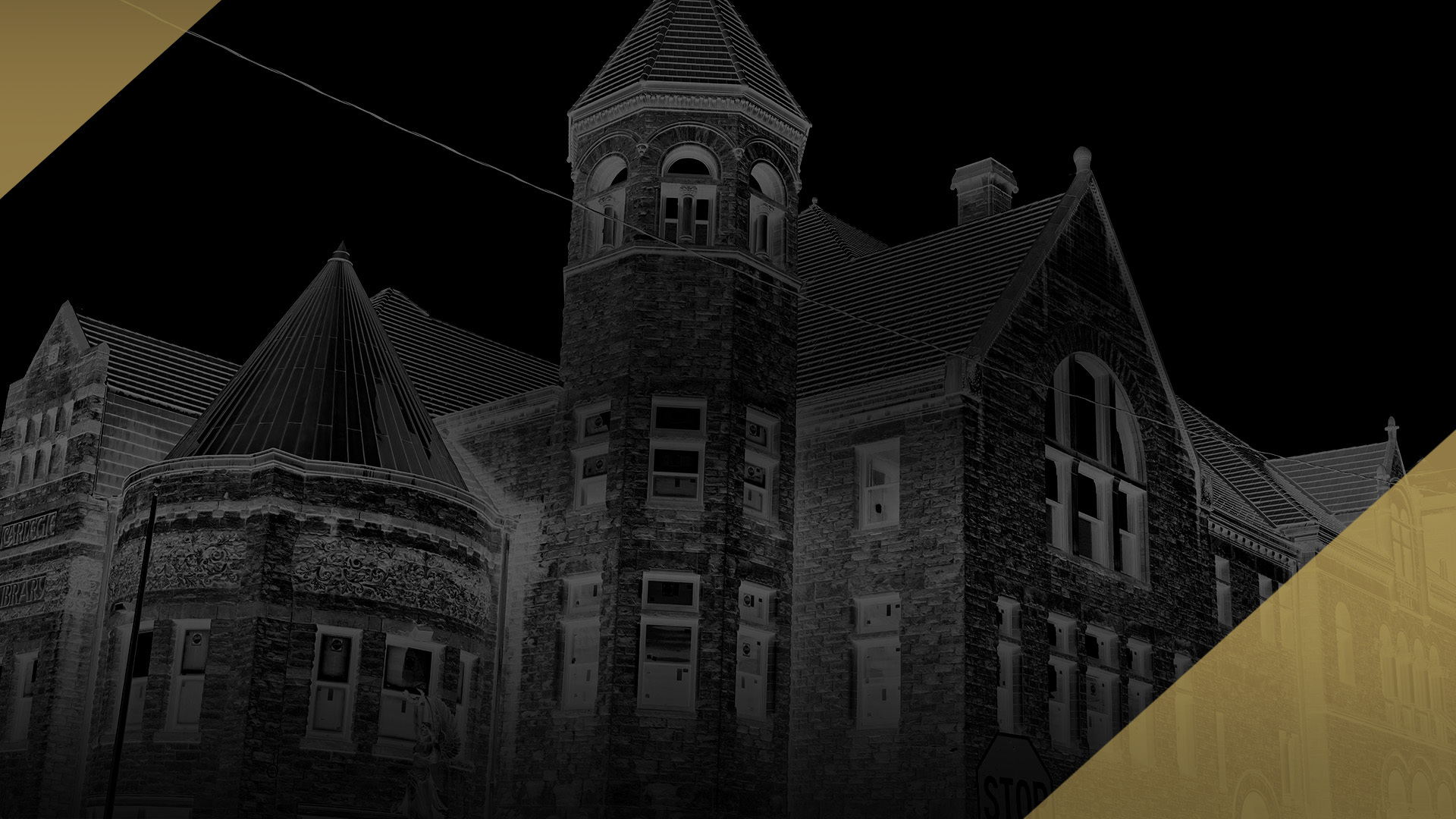
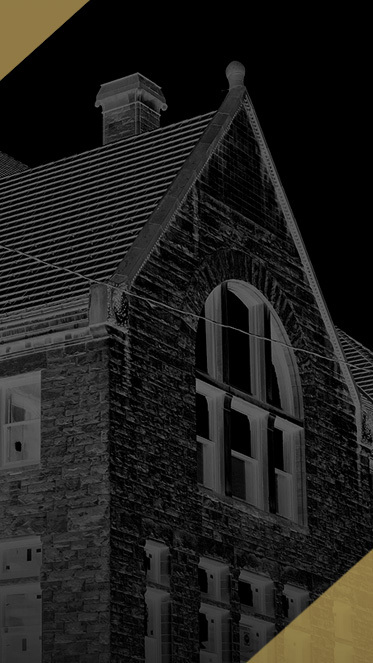
Carnegie Hall is haunted.
No, not the famous one in New York City. That one is too noisy, bustling and bursting with music, seething and sweating from the enterprise of birthing fresh memories each day. The ghosts are in the other ones. The hidden ones. Crumbling, dilapidated Carnegie Halls, tucked away in the suburbs of steel magnate and robber baron Andrew Carnegie’s adopted home of Pittsburgh.

These music halls are relics of a time when the Pittsburgh metro area was the industrial capital of the country, forged in steel and at the confluence of three mighty rivers.
On a dour, drizzly day in April, a metal construction fence rings the Carnegie Free Library of Braddock — an imposing, castle-like structure, the first of Carnegie’s libraries in the United States and one of the first music halls. Discarded lumber and shipping containers of supplies clutter the building’s perimeter. Unfriendly signs warning of “DANGER” shout at passersby.
Once standing tall as a proud beacon of art and industry, the hall now sits in the carcass of a hollowed-out town, a forlorn stone sentinel now looming against gray skies in a steel city that’s still struggling to create a new identity.
Inside the hall is another story entirely.
Mechanical saws shriek and the smell of fresh paint wafts through the air as workers in hard hats scurry about. The facility is under restoration to the tune of $20 million. It’s very much a space in transition.
The same can be said for the five other Pittsburgh halls bearing the Carnegie name, all of which have ebbed and flowed alongside the communities they were built to serve. Not all of the non-New York halls have survived, but those that did have had to continuously reinvent themselves to remain useful.
They continue to evolve today.
Andrew Carnegie, that wee Scottish immigrant, built one of the largest business empires the world had yet seen — before giving most of his billions to philanthropic ventures. At the turn of the 20th century, he gifted six concert halls to different Steel City suburbs. The musical halls were built with uniformly excellent acoustics, each a historical gem in its own right. Perhaps the grandest symbol of opulence: most had functioning pipe organs, also called the “king of musical instruments,” when they were first built.
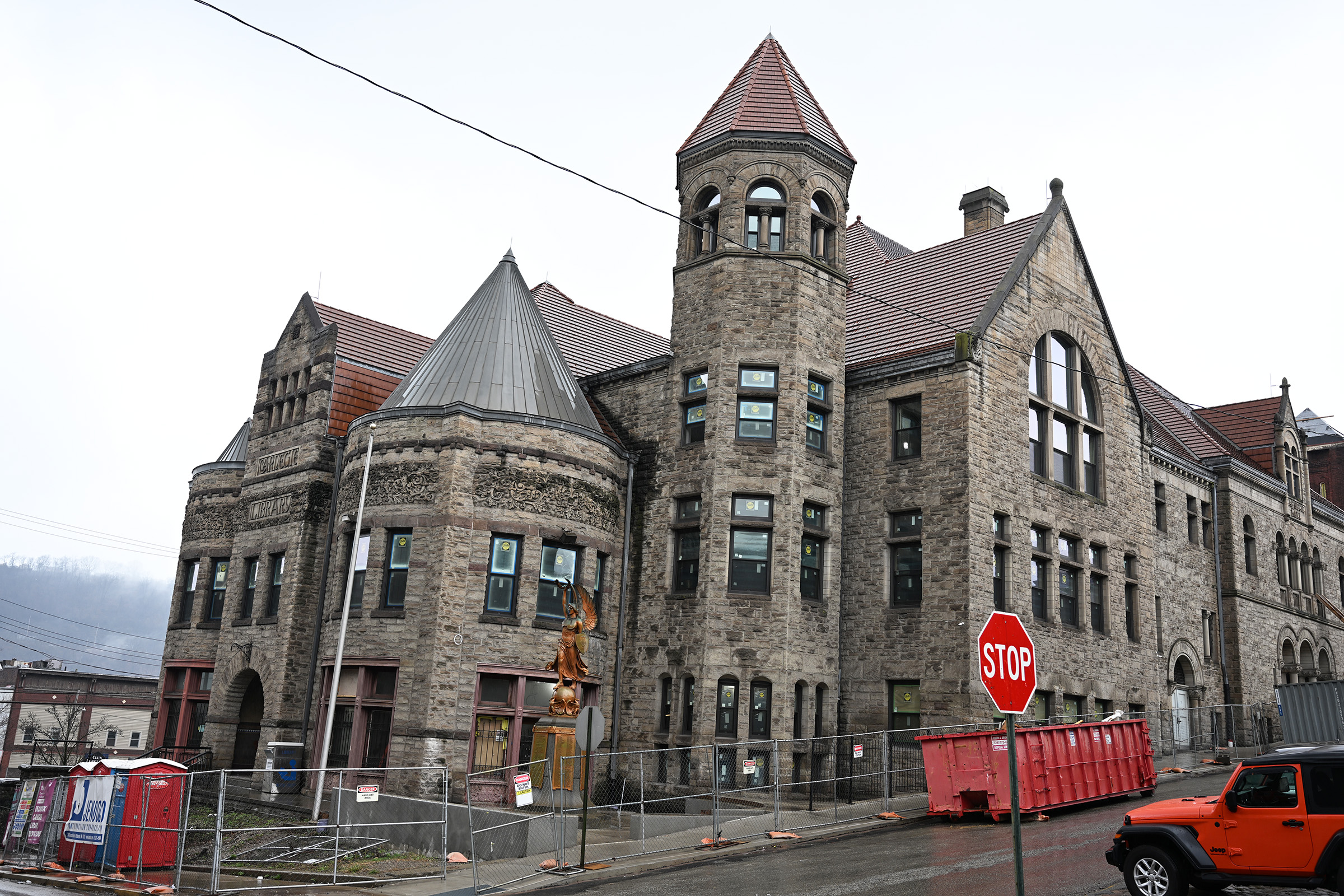
While the Braddock hall was the first to be commissioned, the first to be completed was the Carnegie Hall in Allegheny Center, now an industrial-style black box theater. Other halls are found in the city’s Oakland neighborhood and Pittsburgh-adjacent boroughs of Homestead and Carnegie. There was once a hall in Duquesne as well.
The halls hosted regular recitals of all sorts of music — orchestras, chamber music ensembles, opera singers and more filling the buildings and their steel towns with art and life.
Decades later, they are not the primary performance spaces in Pittsburgh. Those would be Pittsburgh Symphony’s Heinz Hall and the Pittsburgh Cultural Trust’s Benedum Center, both Downtown.
But the music halls are special pieces of Carnegie’s legacy. While the steel baron built more than 2,500 libraries around the world, he only dedicated seven concert halls — most of them attached to libraries and gymnasiums in towns near his steel mills. Carnegie intended them to become community hubs of art, learning and health for workers and their families.
And they were magnificent.
In the latter half of the 20th century — as the U.S. steel industry collapsed in the wake of World War II, facing rising global competition and evolving economic conditions — Carnegie’s Pittsburgh-area music halls fell out of use one by one, except for the one in Oakland.
The others would succumb to disrepair as the town’s populations fled, hunting stable work. Struggling towns sold off or shuttered Carnegie libraries and music halls. The now out-of-tune and out-of-time pipe organs that weren’t stolen or amputated to make space for generators began gathering dust behind the scenes.
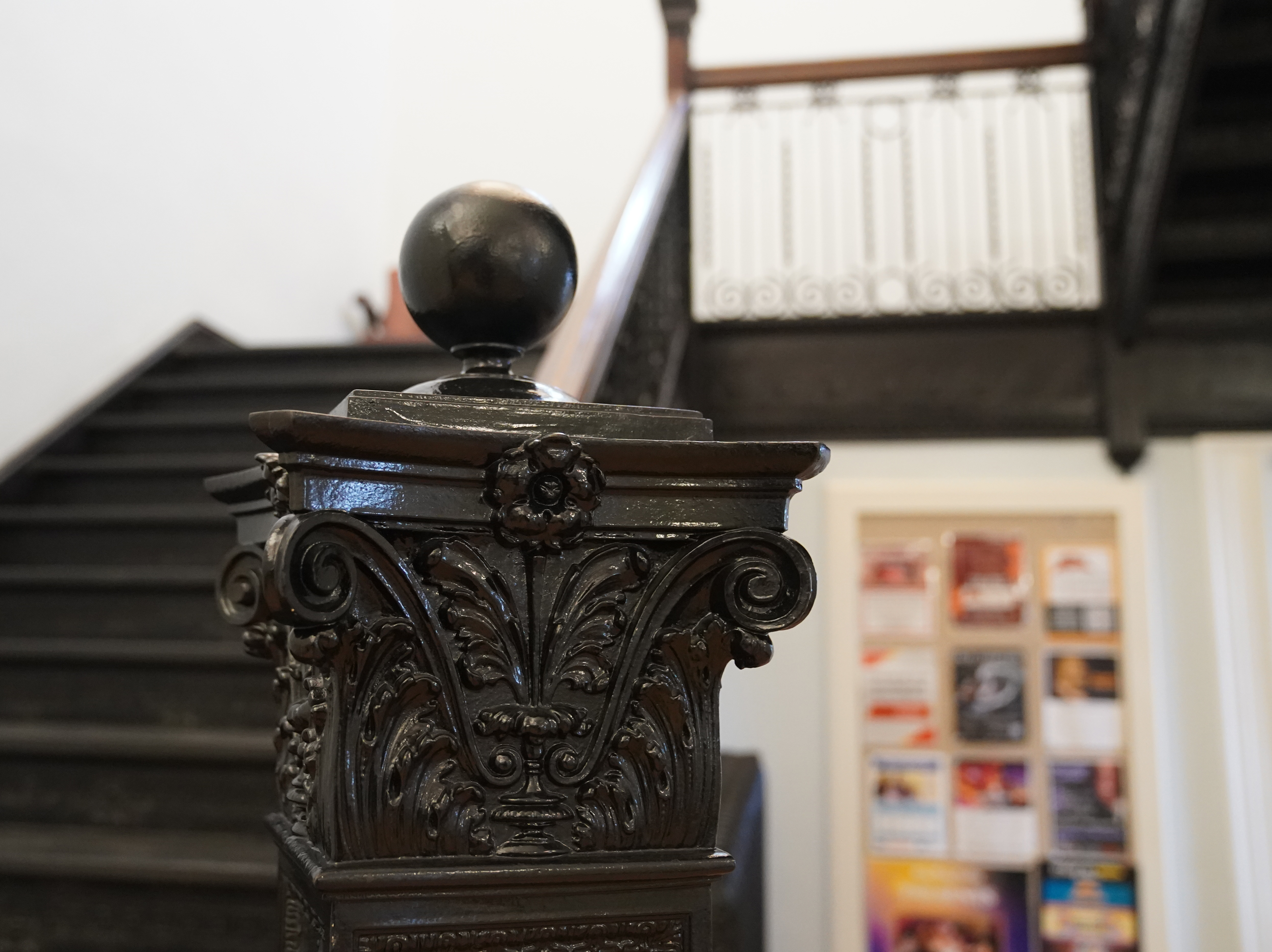
Stages grew dark, for a time. The Duquesne hall was razed altogether. As the halls were shuttered, however, stories began to swirl and take shape. The ghosts began to fester. Each of the halls now has tales of doors slamming with no breeze and locks locking or unlocking spontaneously — even floating specters have been reported over the decades.
Meanwhile, Andrew Carnegie’s Pittsburgh legacy continues to slowly erode.
The Japanese company Nippon Steel has made an offer to purchase U.S. Steel, the company forged when J.P. Morgan merged the Carnegie Steel Company with the Federal Steel Company and the National Steel Company in 1901. And Pittsburgh’s Carnegie Science Center is set to be renamed the “Kamin Science Center,” after a historic $65 million gift from a new donor.
Most of the old music halls are in a state of transformation as well, with local philanthropists and foundations pumping cash into the halls to preserve these luxurious bits of history.
In addition to the repairs in Braddock, the hall in Homestead — now managed by a for-profit entertainment company on behalf of its library — is preparing to install new seats to the tune of about $1 million. The hall in the borough of Carnegie is fundraising to install an HVAC system that would allow year-round operations. Even the Oakland hall — the closest analog to Carnegie New York — recently completed an $8 million renovation to restore the opulence and majesty of the original structure.
For now, Carnegie’s music halls — those still standing at least — will remain.
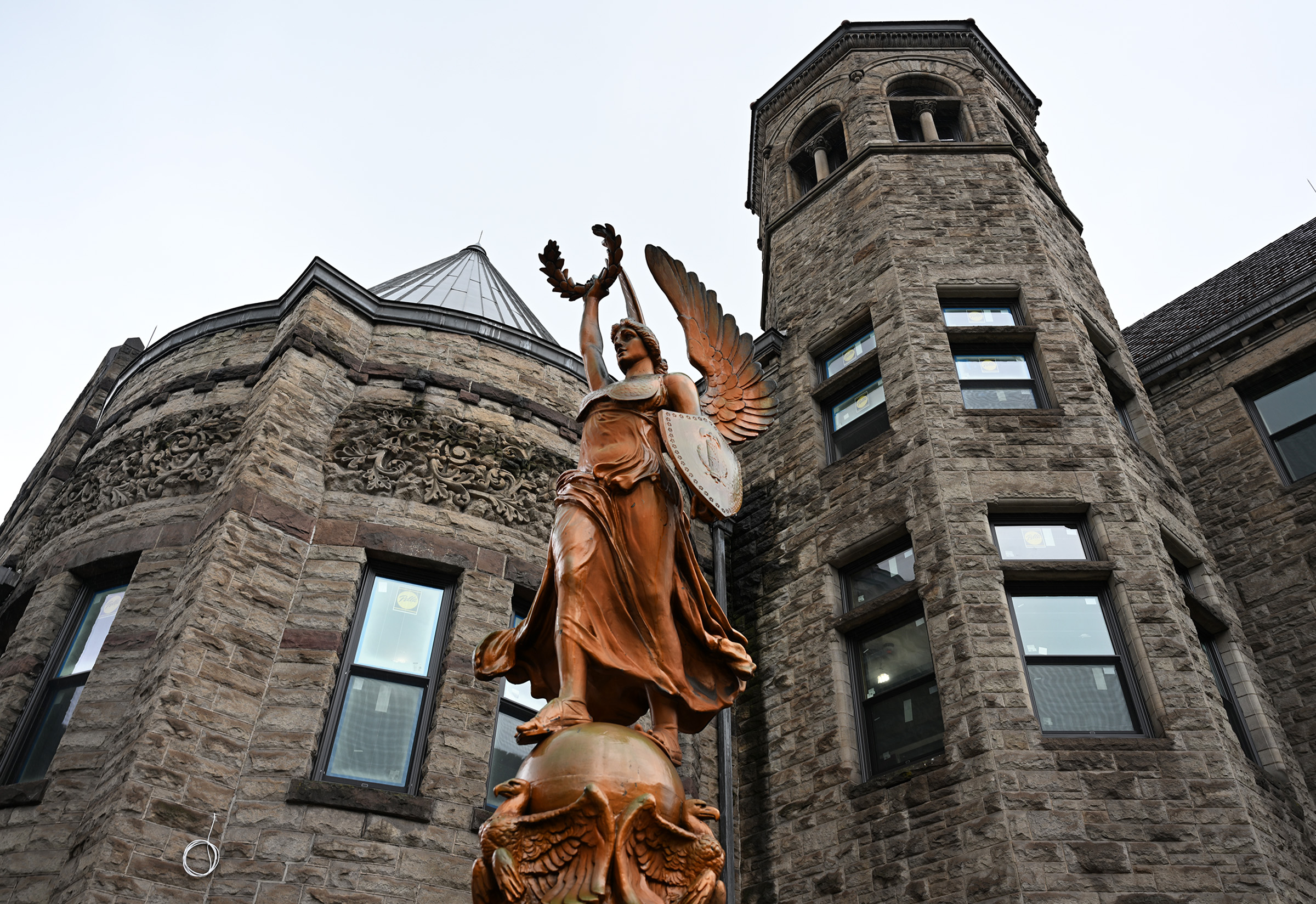
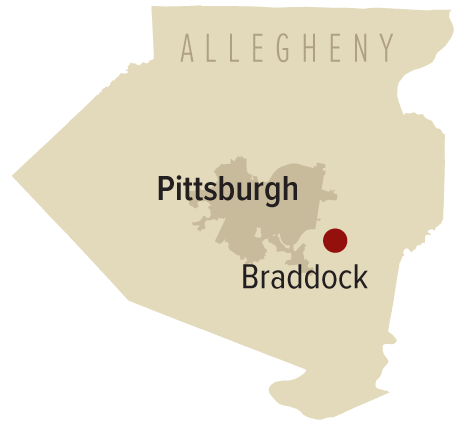
It’s impossible to separate Carnegie’s legacy as a steel baron from his philanthropy.
There’s no clearer symbol than that built into the Carnegie building in Braddock, where an actual tunnel connects the original steel mill to the library’s gymnasium where workers in the 19th century would go to wash up after a day at the mill before heading home to dinner or staying to catch an organ recital.
Year completed: 1893
Architect: Longfellow, Alden and Harlow
Original cost: $357,782
Historic landmark: Yes
Seating capacity: 500
Rentable: No
Types of events: Concerts, dance, theater
Organ: Stolen
Liquor license: No
Air conditioning: Yes
The borough of Braddock holds a storied, pivotal place in history. Long before the steel boom years, it was the site of the 1755 Battle of the Monongahela, where a young Col. George Washington distinguished himself.
Once a thriving industrial city with a population around 21,000, Braddock’s population now sits around 1,700, per 2020 U.S. Census data.
Bits of hope have come and gone. In 2019, U.S. Steel announced plans for a $1 billion investment in the Mon Valley Works — Edgar Thomson Plant to turn the site into a state-of-the-art facility. But those plans were canceled in 2021.
The library — a grand, monolithic building that also encompasses a gymnasium and music hall — is another story.
Carnegie built the library in 1889, adding the other components in 1893. The steel mill provided operating funds for the building for decades, but sold it to the local school district in the 1960s. The library shut its doors in 1974 due to lack of funds. It was scheduled for demolition.
David Solomon, the very last librarian at Braddock, leapt into action. He bought the building from the city for $1 and formed the Braddock Carnegie Library Association to shore up the roof and secure the building. It has seen some limited use since then.
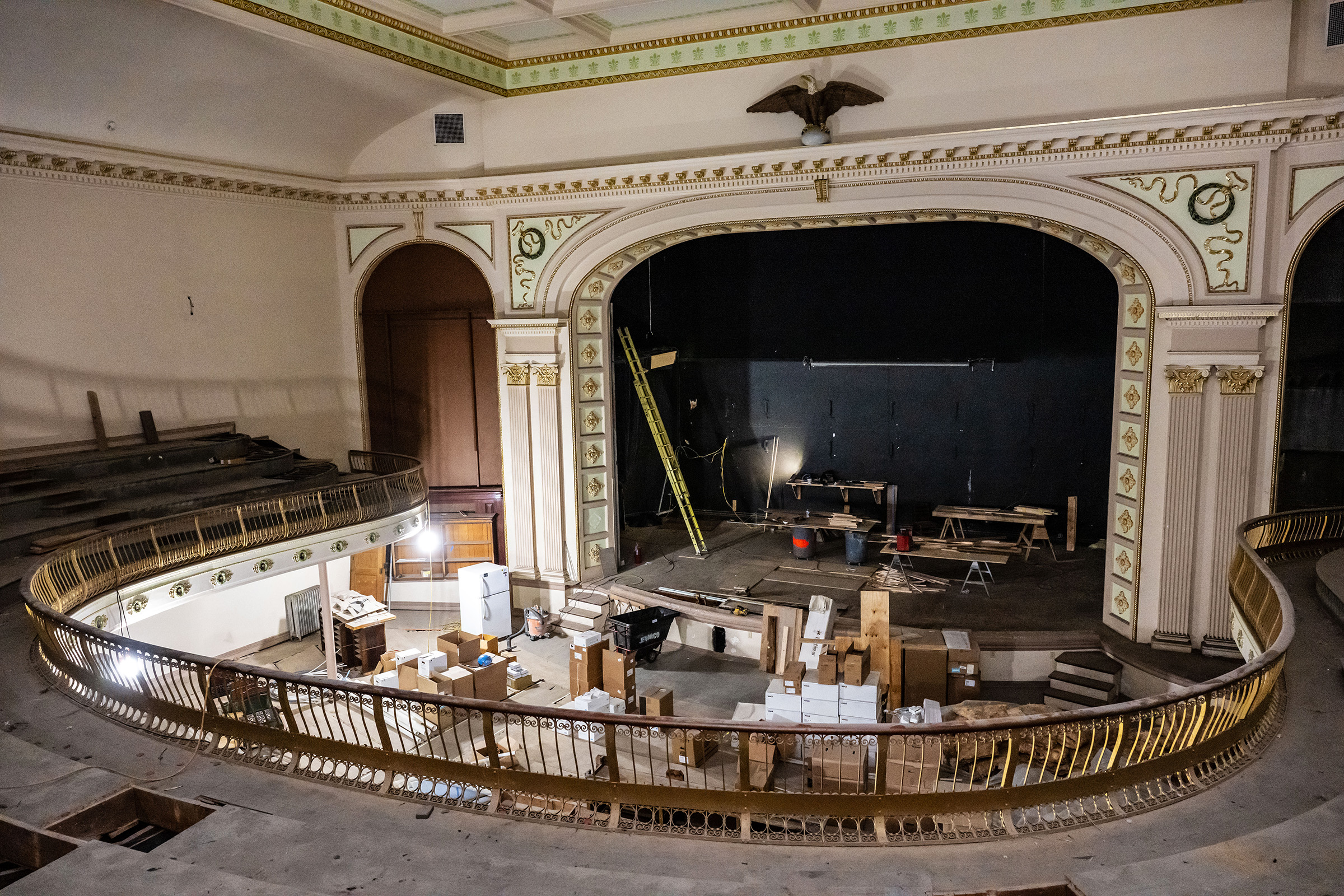
“I remember being in plays as a student here back then,” said Victoria Vargo, executive director of Carnegie Free Library of Braddock. “We were cowgirls with little cap guns. ... That’d probably never fly today.”
Renewed interest in the library and town have attracted significant funding more recently. Construction crews broke ground in May 2022 on a $20 million restoration of the library. The building is expected to reopen to the public in 2025 with a new elevator, central air conditioning and significant restoration to the woodwork and craftsmanship.
The hall is currently a hard-hat zone, stripped down to its skeleton and in a state of bustling construction. All is stone and dust and faded grandeur, with tight passages and stairwells connecting the different pieces of the structure. With workers tending to the floors, the stage, the ceiling — there’s an air of promise.
Improvements include a new sound system, lighting upgrades and new seats, which will roughly halve the hall’s capacity from its original 1,000 seats.
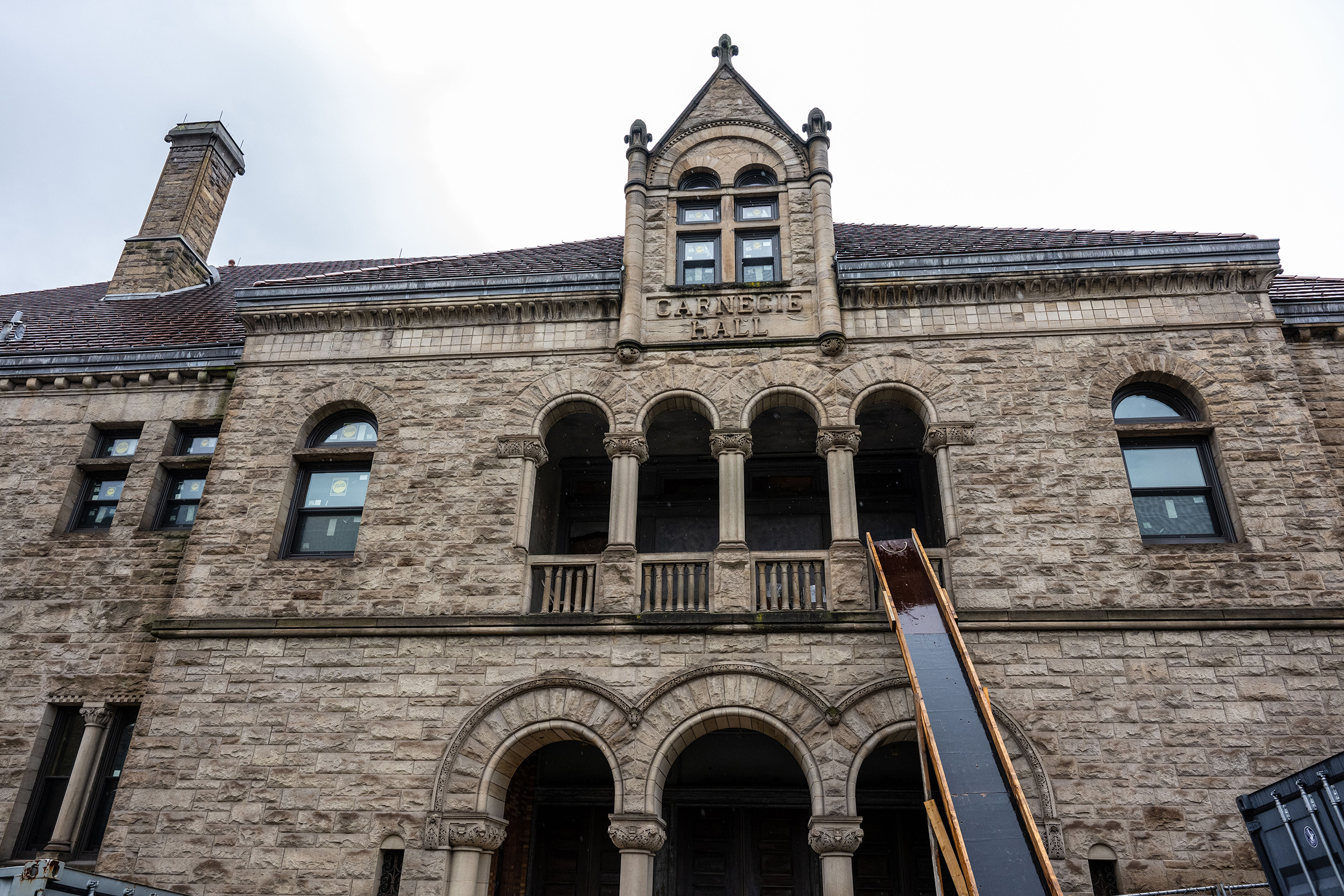
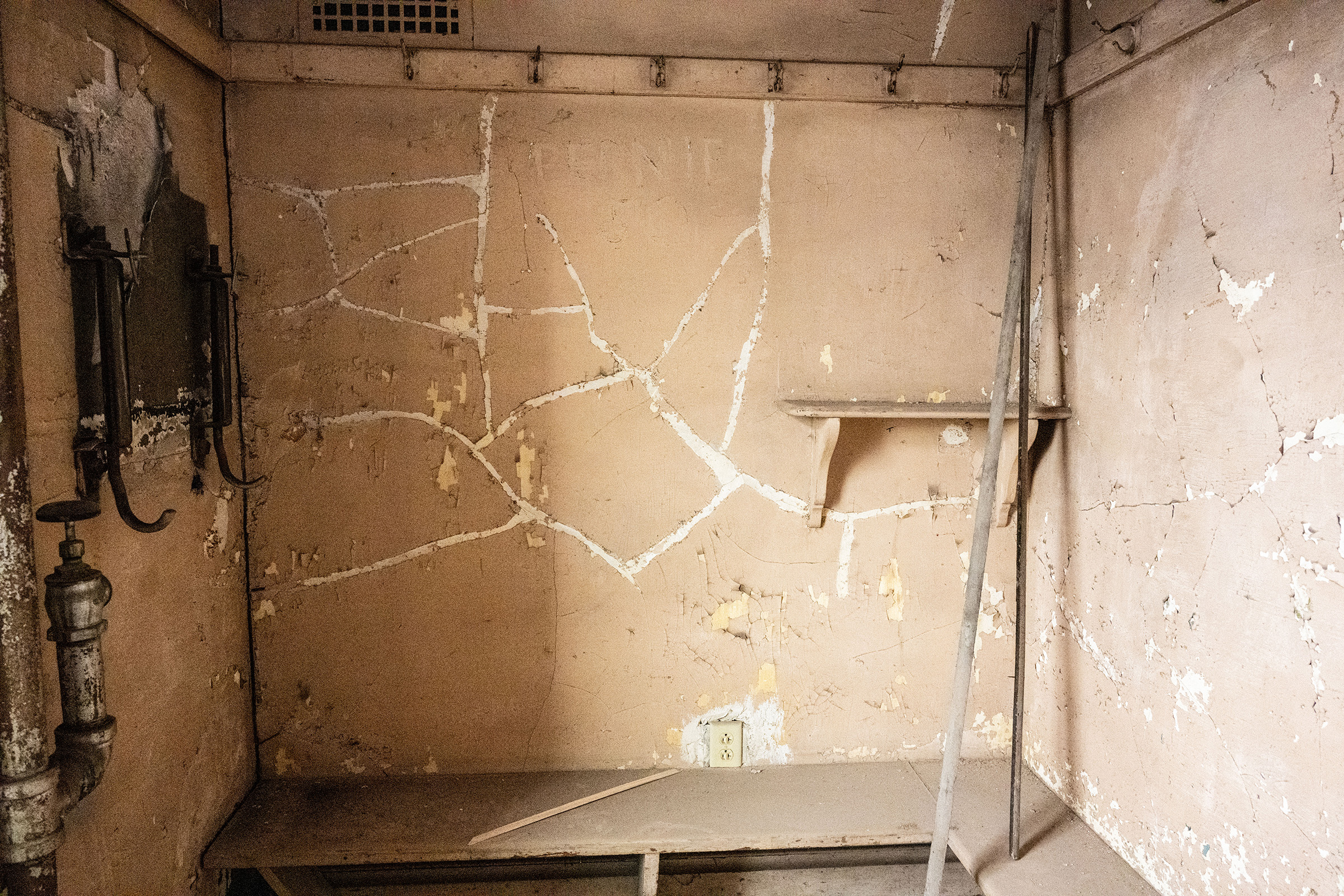
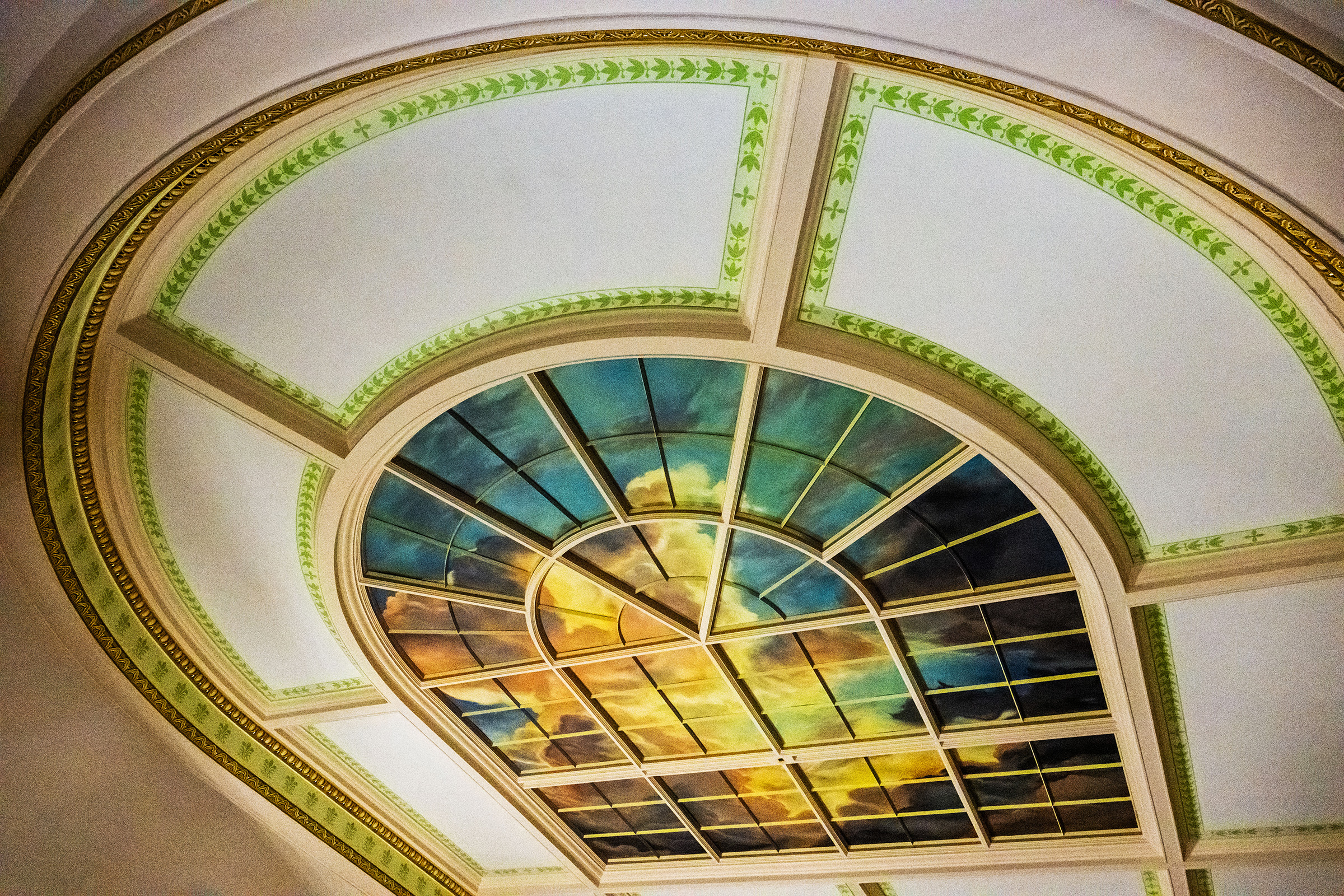
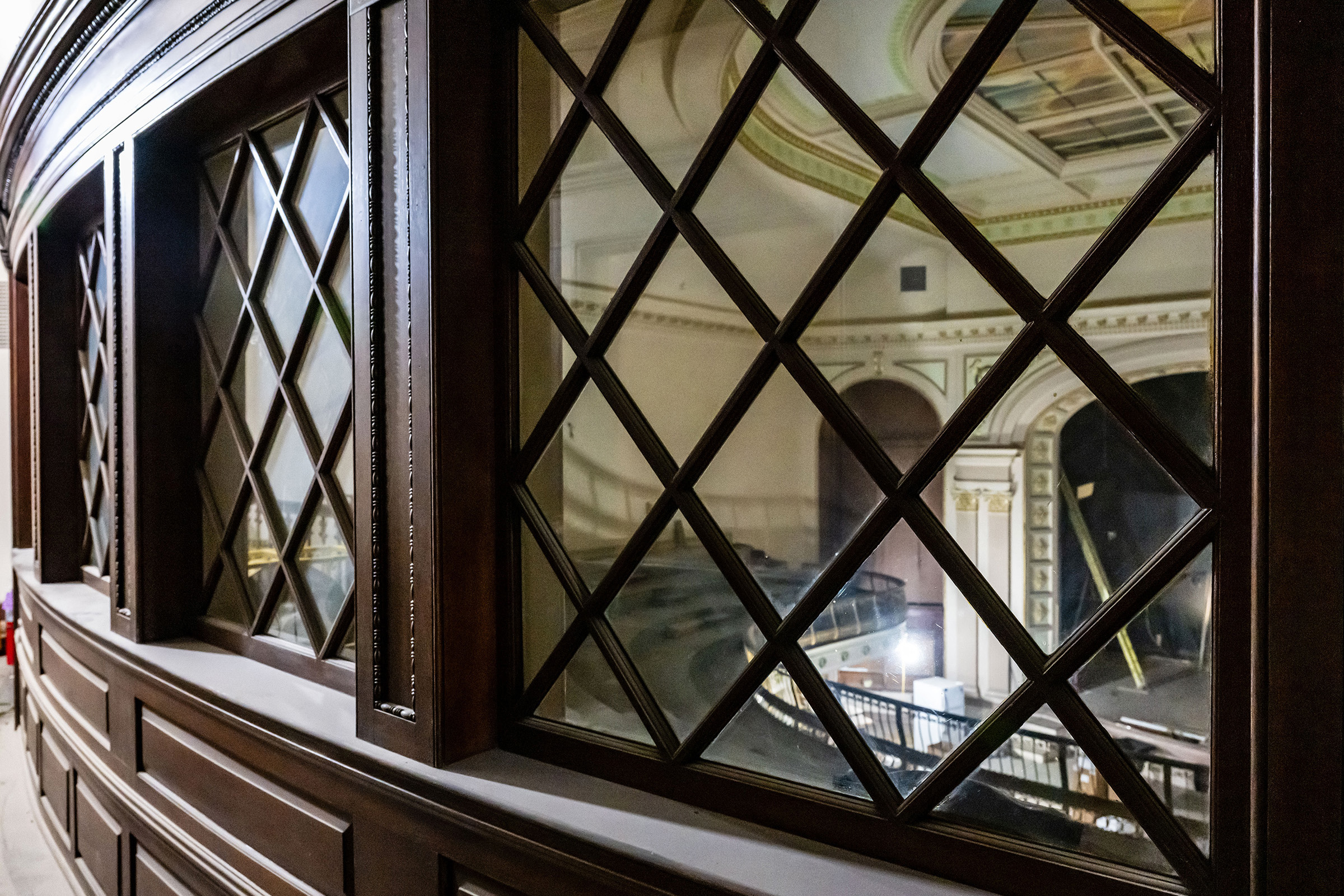
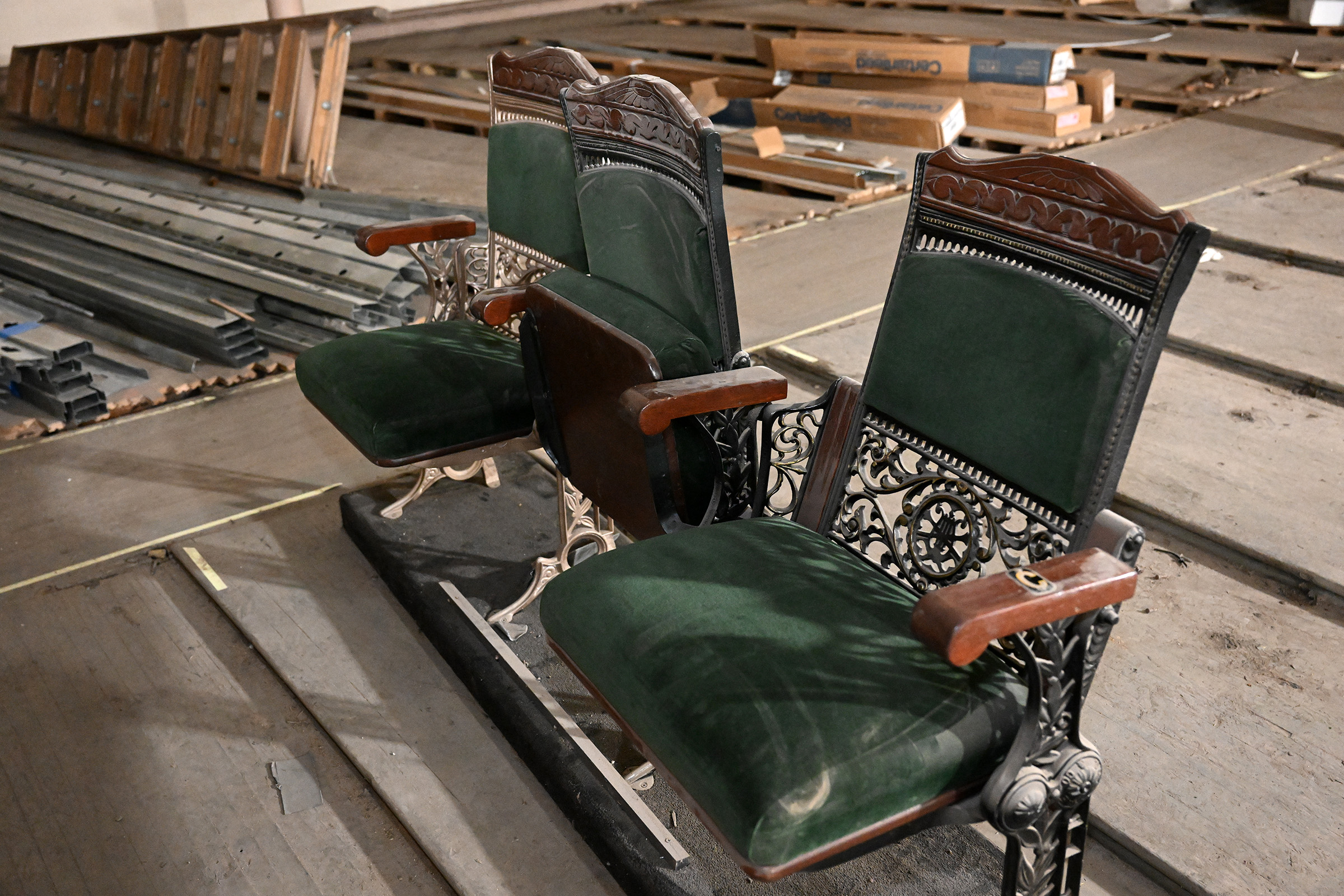
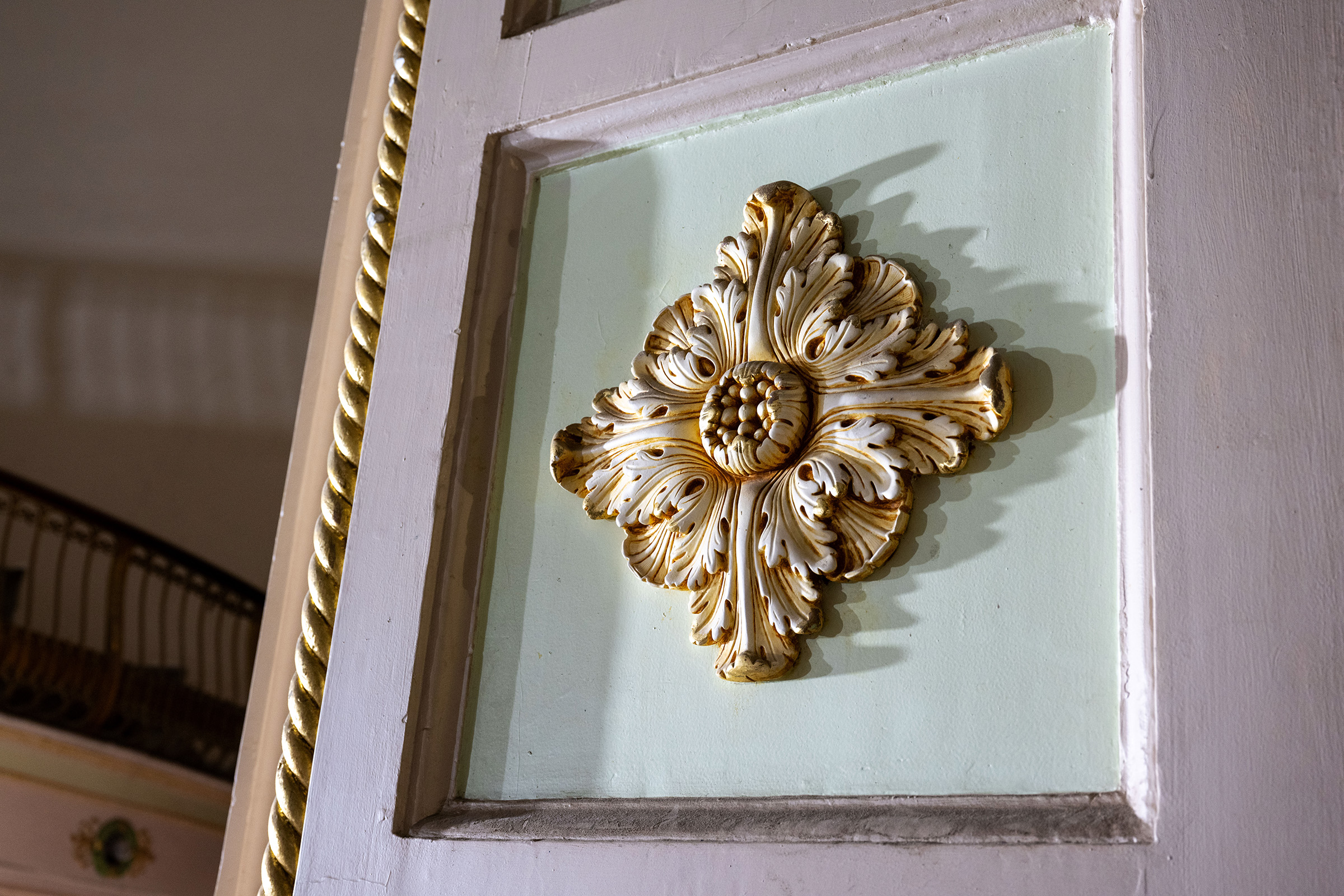
Like the other halls, Braddock’s once housed a grand pipe organ for recitals, but the pipes have been stolen over the years for their steel. It would cost more than $800,000 to restore the instrument, which currently isn’t feasible.
The hall will host a local dance studio, school productions and other performances curated by the library, which will operate with an annual budget of around $850,000.
“It’s a grand old lady. She deserves it,” Vargo said.
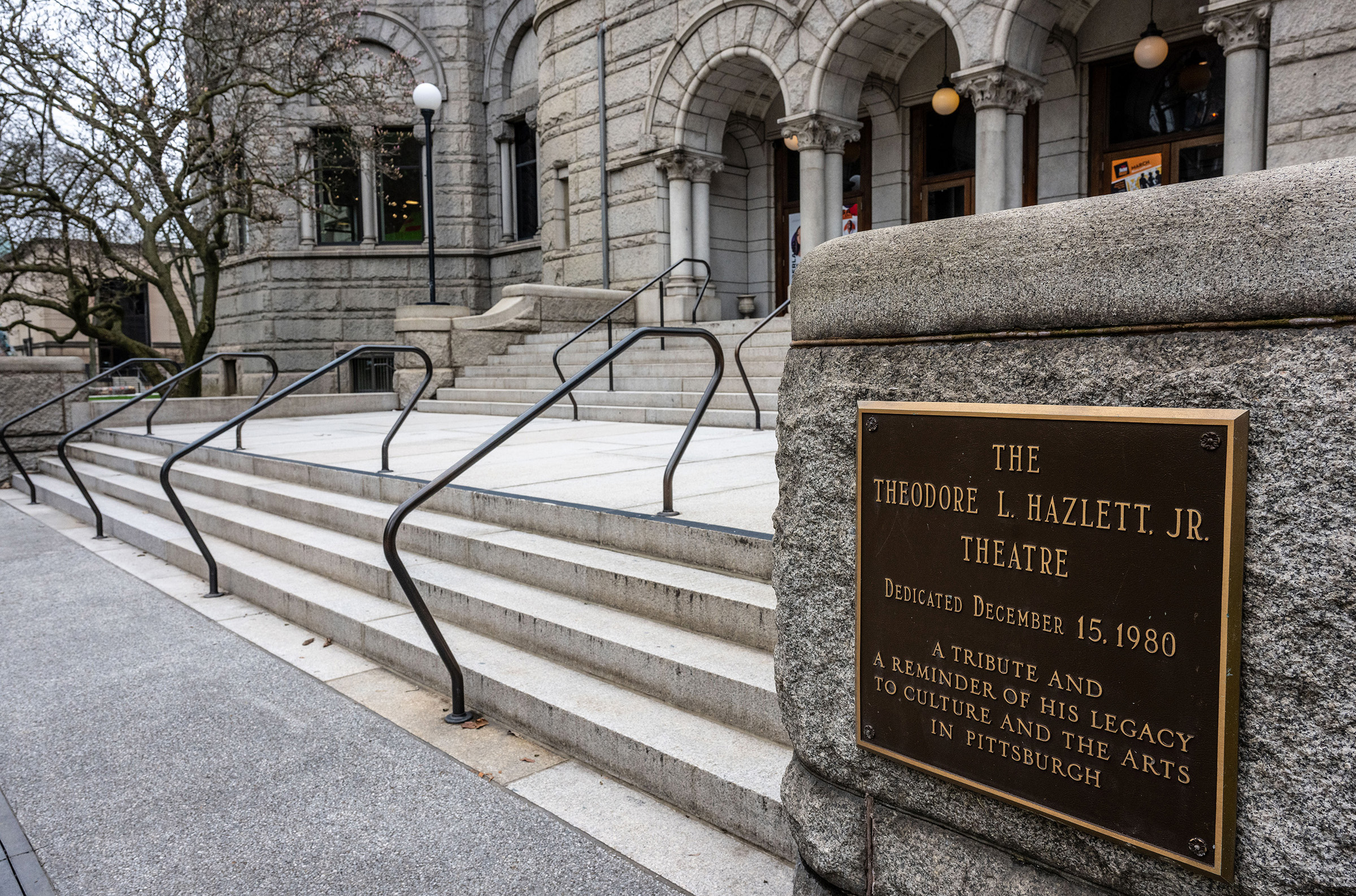
Some say that Andrew Carnegie gave away his vast fortune out of guilt. They clearly haven’t read his prenup.
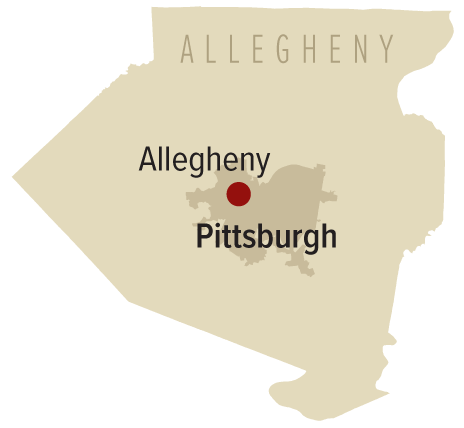
Carnegie married Louise Whitfield in 1887, long before his relationship with organized labor turned bloody. He had his bride sign a document that guaranteed her an annual allowance of $20,000 — an enormous sum at that time — but stipulated that the rest would be donated for educational and charitable purposes.
Year completed: 1890
Architect: John L. Smithmeyer and Paul J. Pelz
Original cost: $300,000
Historic landmark: Yes
Seating capacity: 500
Rentable: Yes
Types of events: Concerts, theater, weddings, other events
Organ: Removed
Liquor license: Yes
Air conditioning: Yes
Whitfield, who by all accounts was quite a generous and noble person and influential with her husband, was in full agreement.
It was around this same time that Carnegie commissioned his first library, the Carnegie Free Library of Allegheny, which included a music hall, in the modern day Allegheny Center in the North Side. (Pittsburgh annexed Allegheny City in 1907.) Although this library was the first to be commissioned, construction on the Braddock library was completed first. Braddock’s music hall was added later in an addition.
The Allegheny Carnegie, completed in 1890, was the first Carnegie Hall in the United States. It is the only Pittsburgh hall that no longer bears his name.
Carnegie’s motivations were never simple. The steel trusses for the hall’s ceiling — a high, vaulted affair — likely were used as a demonstration of new technology and building possibilities offered by the rapidly expanding Carnegie Steel Company.
As Pittsburgh’s population winnowed out in the latter half of the 20th century, funding for the library and music hall plummeted, and the city nearly demolished the building. Community funders stepped in, raising enough cash to renovate the space.
What was once an elegant, 1,000-seat theater that closely resembled the Carnegie Halls in Homestead and Braddock became a more industrial space, with exposed stone and its windows walled up to create a black-box theater.
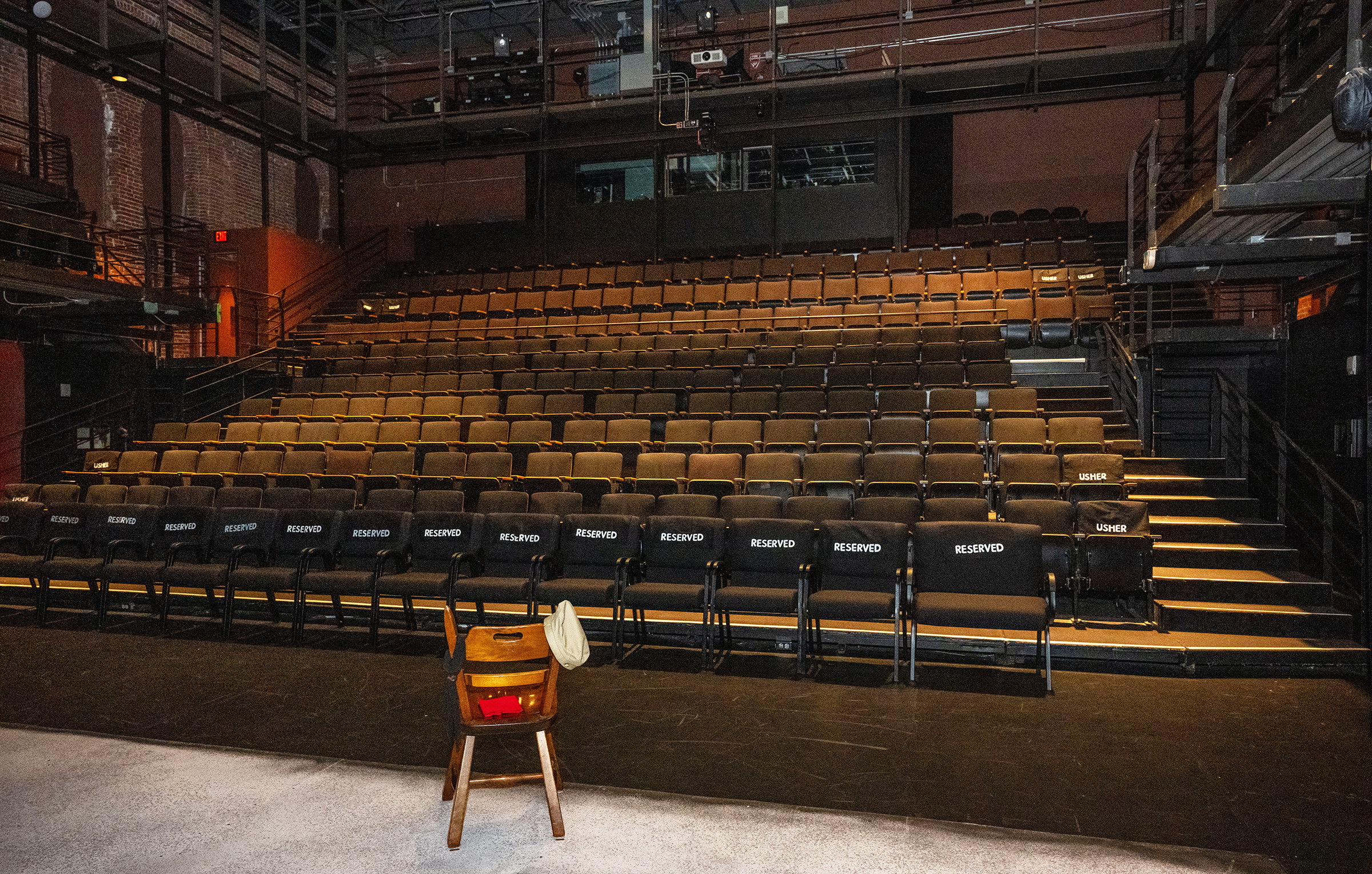
The plaster was ripped off the walls. The balcony was removed. Half of the theater was walled off to become a lobby on the first floor and a rehearsal space on the second, leaving a more intimate performing space with dry acoustics and adjustable seating. The hall’s new capacity is about 500.
Of the remaining Steel City music halls, this one least resembles its original design, though it still upholds its founding purpose as a site for community art and performances.
Pittsburgh Public Theater operated the building from the 1970s to the 1990s, and it was renamed the Hazlett Theater in 1980 in honor of Theodore L. Hazlett Jr., a Pittsburgh power player and a fierce supporter of the arts who had died the year before. In 2006, five local arts and community organizations joined forces to create the New Hazlett Center for the Performing Arts, which currently occupies and manages the space.
“The city actually still owns the theater, but the deed is lost,” said Scott Conklin, director of operations at the New Hazlett Theater.
The Children’s Museum of Pittsburgh operates the library space, which reopened in 2019 after closing in the mid-2000s due to a lightning strike on the clock tower. (“It’s very ‘Back to the Future,’” Conklin said. “The clock still doesn’t work.”)
Another peculiarity for this hall: It also served as a place of religious retreat for the Watch Tower Bible and Tract Society, one of the main entities that distributes doctrinal material for Jehovah’s Witnesses.
“They still show up on tour buses all the time,” Conklin said.
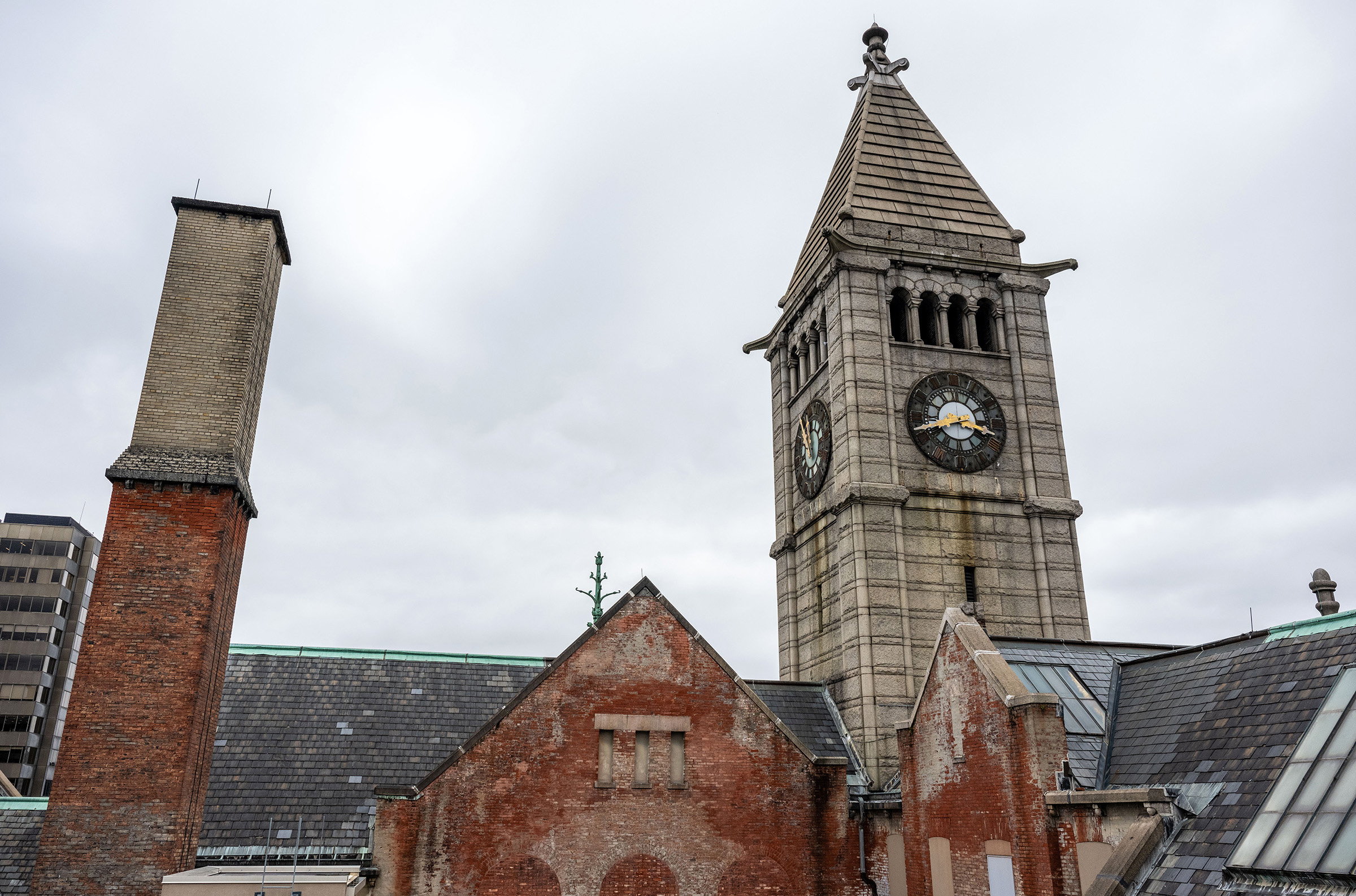
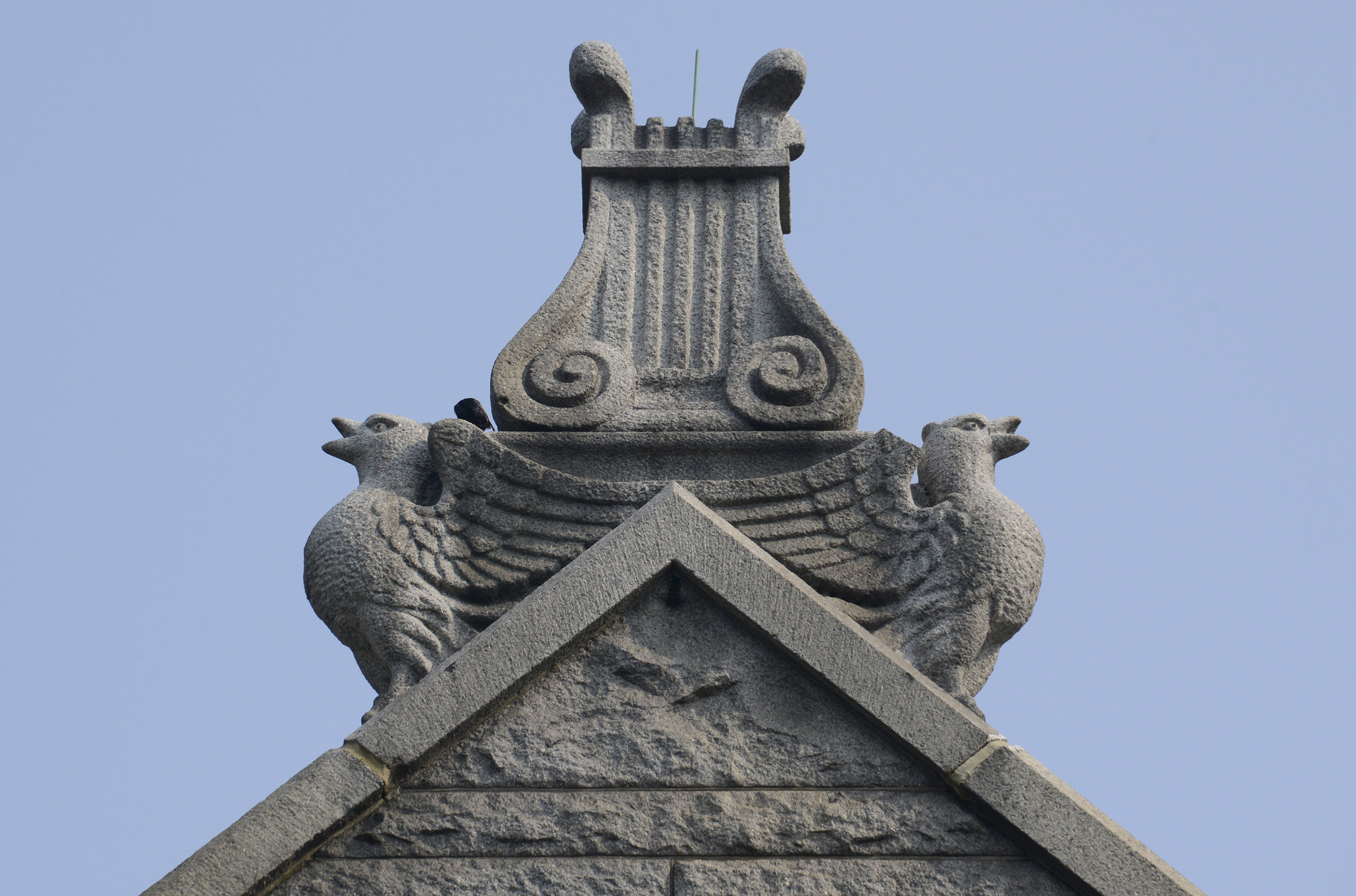
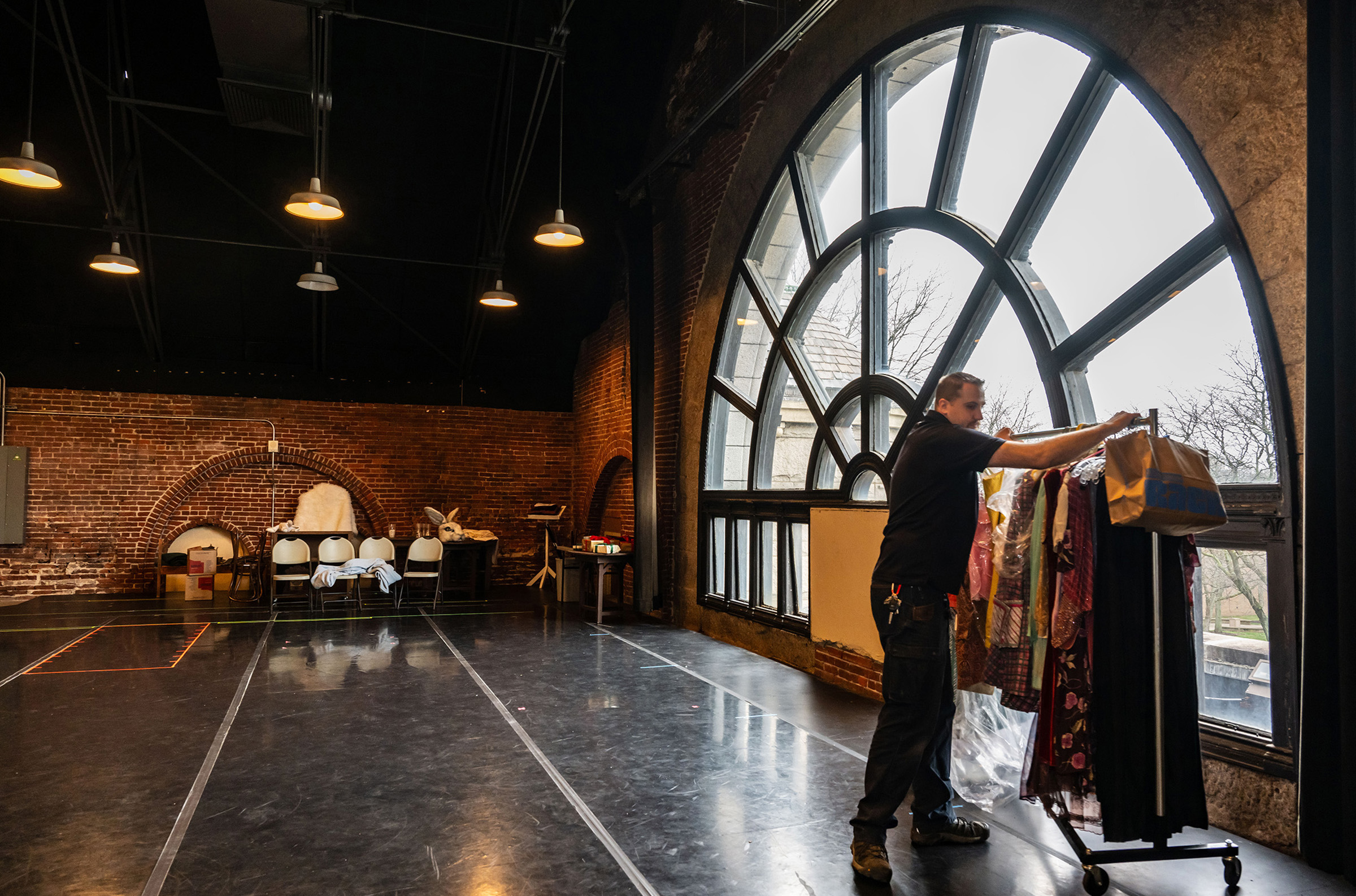
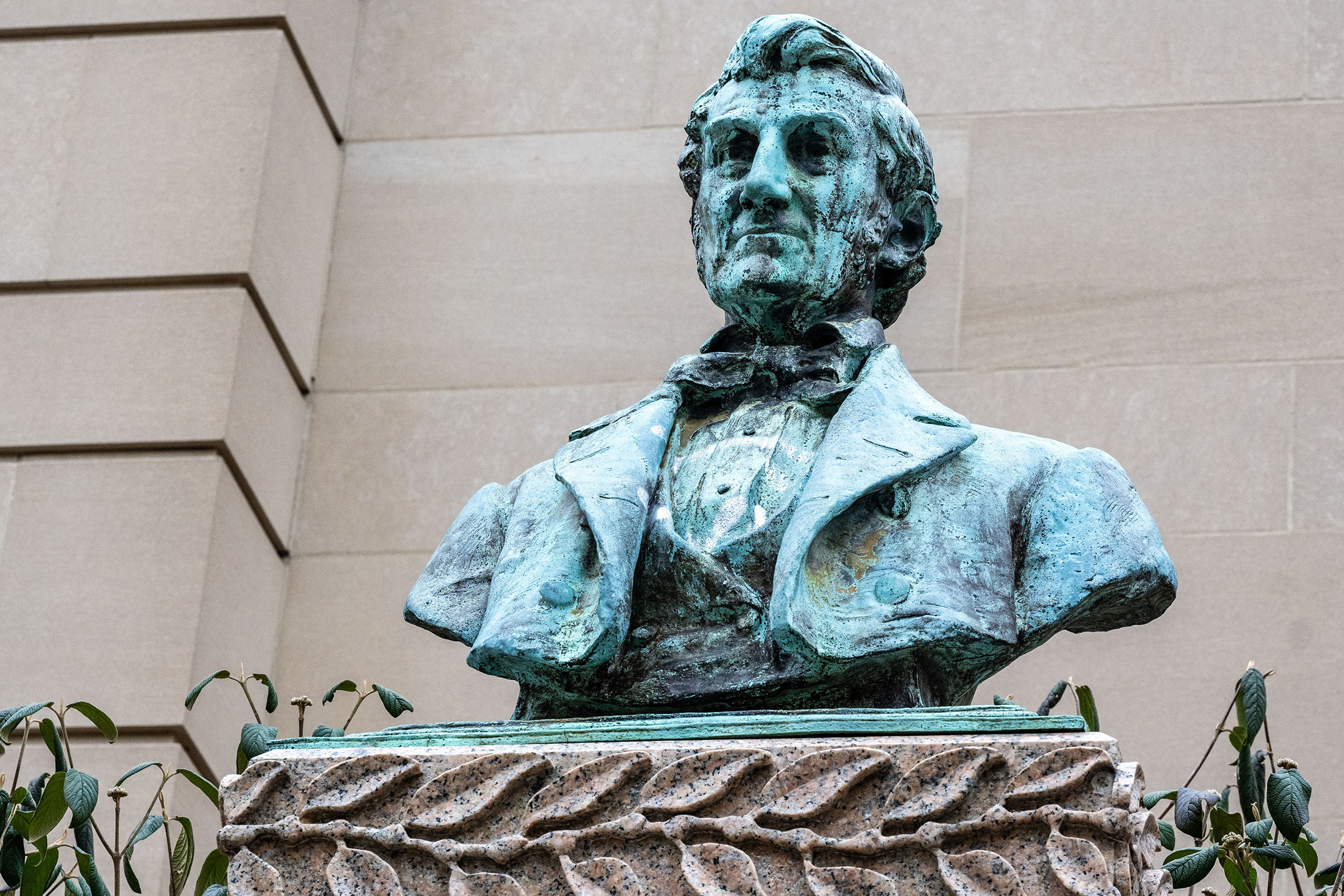
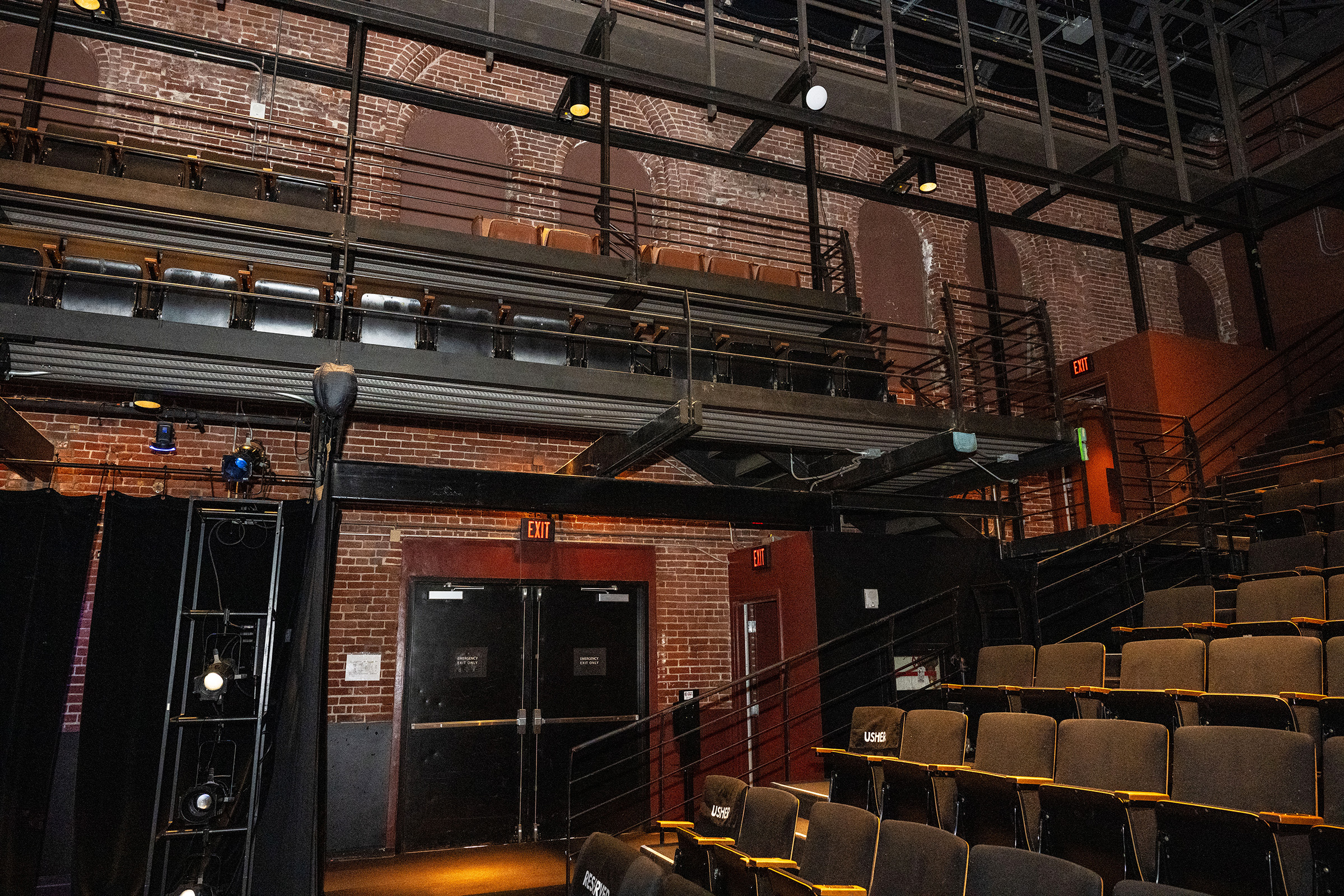
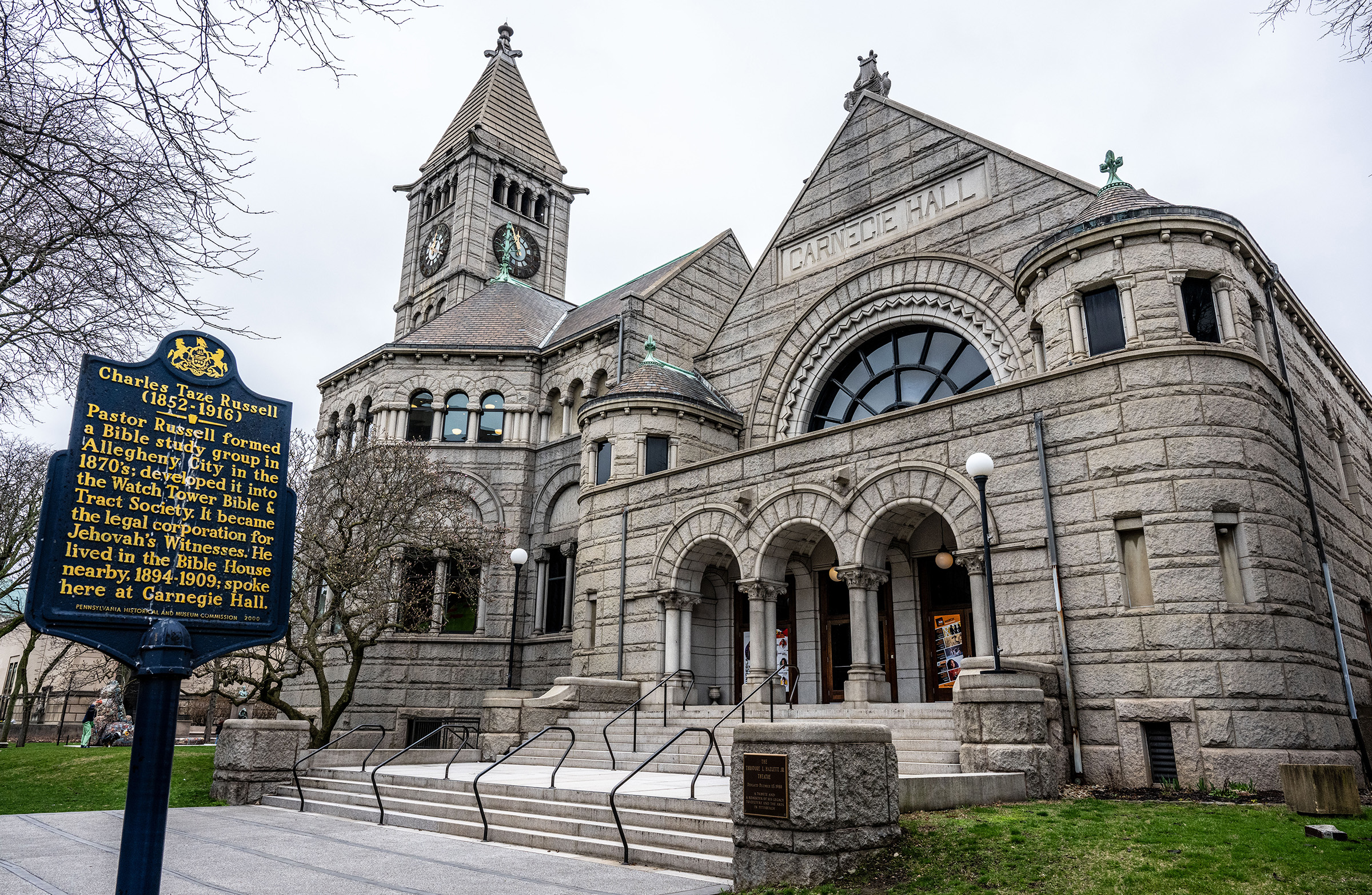
The renovated theater has a high-end sound system and hosts a variety of small-scale theatrical productions and concerts, weddings, bat mitzvahs, proms and more. Philanthropic funding ensures that rental prices remain affordable for small local organizations.
In recent years, the hall installed a state-of-the-art HVAC system with COVID-19 pandemic funding and has done significant work on its front steps, to the tune of about $300,000.
“Now we just need to cover up the odd bullet hole here and there,” Conklin said, pointing out examples of old shots.
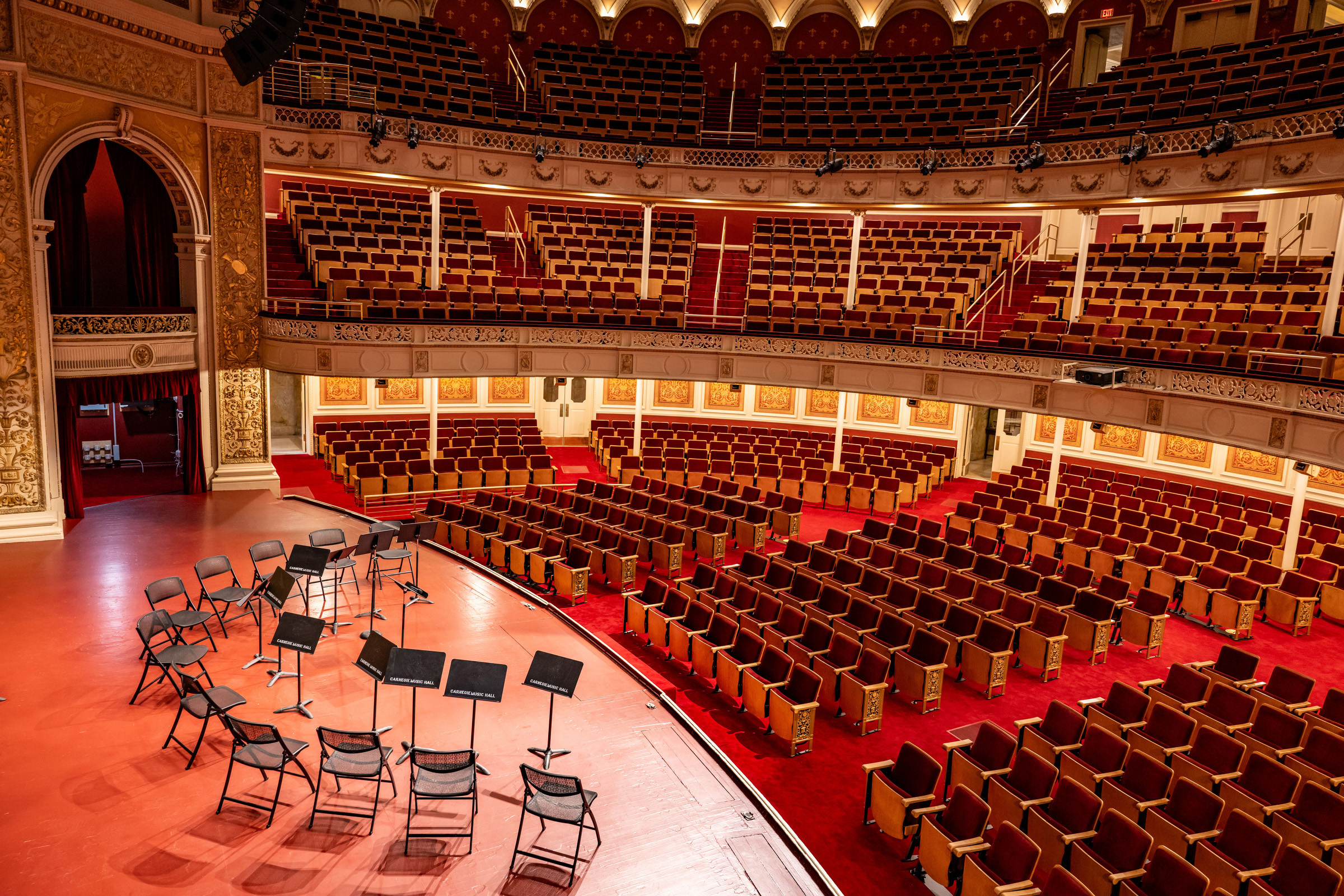
A Boston writer described Pittsburgh as “hell with the lid off” in the mid-19th century, an assessment that captain of industry Andrew Carnegie confirmed in his 1920 autobiography.
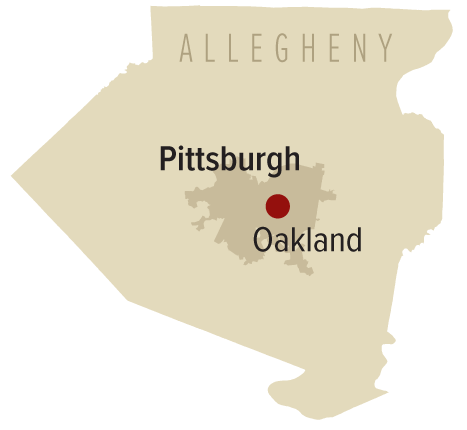
“The smoke permeated and penetrated everything,” he wrote. “If you washed your face and hands, they were as dirty as ever in an hour. The soot gathered in the hair and irritated the skin, and for a time ... life was more or less miserable.”
To make life bearable, a young Carnegie — who emigrated with his family from Scotland to Pittsburgh in 1848 — took advantage of his job as a messenger in the city’s telegraph office to make deliveries to a local theater, where he’d often stay late to sneak glimpses of works by Shakespeare and other great playwrights. He also was a frequent visitor to a local library, where he’d pore over books for hours at a time, according to numerous biographies.
Year completed: 1895
Architect: Longfellow, Alden and Harlow
Original cost: $1 million
Historic landmark: Yes
Seating capacity: 1,530
Rentable: Yes
Manager: Carnegie Museums of Pittsburgh
Types of events: Concerts, lectures, weddings
Organ: Yes; out of tune
Liquor license: Event license
Air conditioning: Yes
It’s no coincidence, then, that some of his most lasting contributions to humanity were his libraries and performance halls.
The greatest of these spaces in Pittsburgh is the Oakland facility, which houses the main branch of the local library system, the Museums of Art and Natural History, and the largest and most magnificent of Pittsburgh’s Carnegie Music Halls.
That music hall, owned and managed by the Carnegie Museums of Pittsburgh, is by far the grandest and best maintained of the five remaining Pittsburgh halls. In March, a grand reopening ceremony was held to celebrate the completion of a $9 million renovation that brought central air-conditioning, an upgraded sound system and extensive restoration of the craftsmanship that makes the hall so ornate — delicate scrollwork and light fixtures, rich, red carpeting and more.
The renovation also brought significantly larger and more comfortable seating, reducing capacity from nearly 2,000 to about 1,530.
“We put a time capsule up at the top of the arch over the stage, at the scroll,” said Melissa Simonetti, Carnegie Museums of Pittsburgh’s director of construction and project management, noting that the hall’s last major renovation occurred in the 1970s. (The capsule includes letters from the facilities department.)
To repair some of the lighting sconces, crews called in additional experts. Preparators from the Museum of Natural History’s paleontology department, who are used to creating casts of missing dinosaur bones to complete skeletons, helped with the recreation of some of the hall’s lighting sconces.
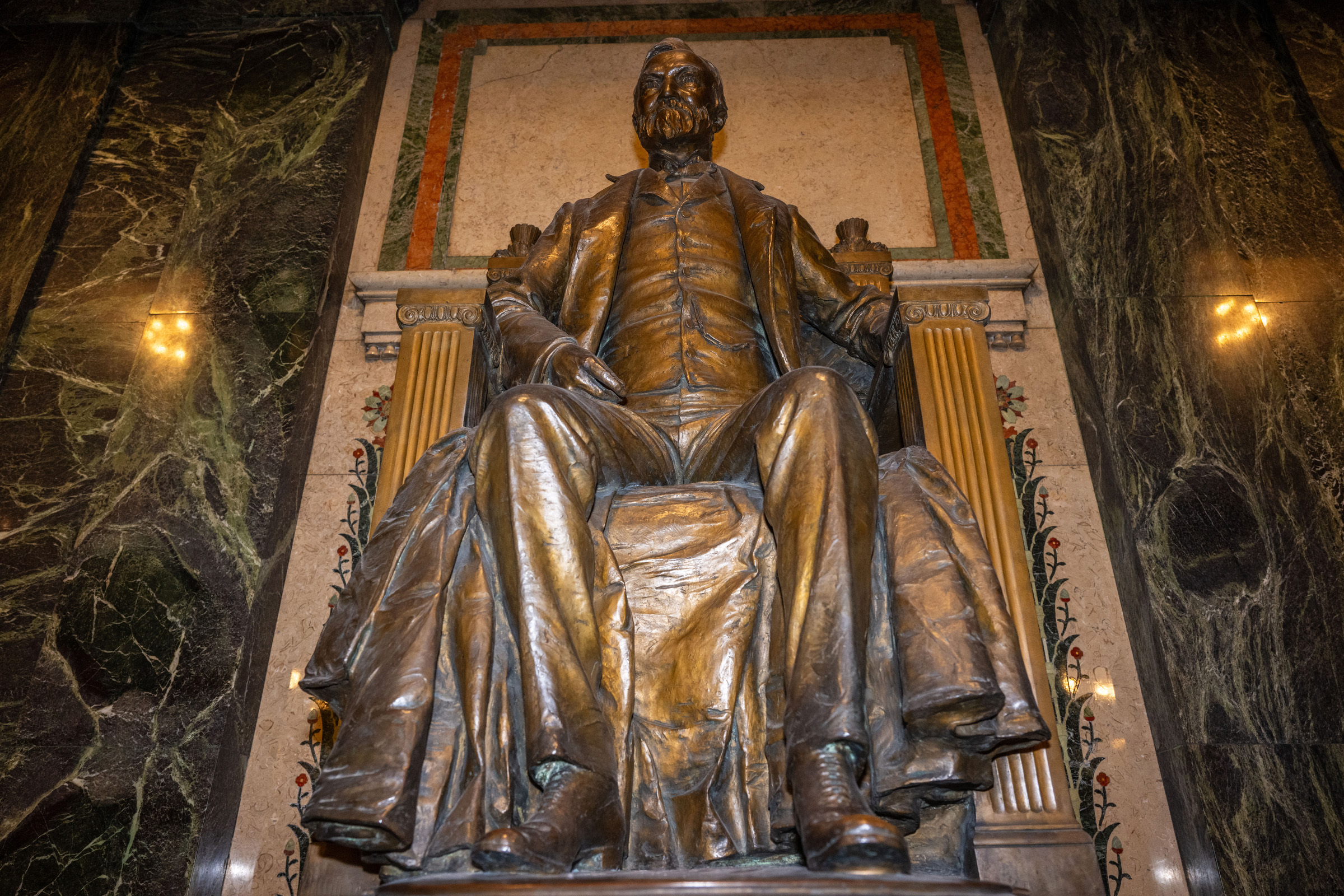
An early incarnation of the Pittsburgh Symphony Orchestra once performed in the hall. Today, the Carnegie Mellon University Orchestra plays there regularly, along with others in the city’s instrumental landscape. The hall also hosts the Pittsburgh Arts & Lectures series.
“Everyone’s been asking about the acoustics — we were very careful and the sound isn’t measurably any different than it was before,” Simonetti said.
Seating in this hall stretches over three stories, including two opera boxes on either side of the stage. (The drapes still smell a bit musty.) The hall’s pipe organ is still operable, but it’s in a state of disrepair and would cost nearly $2 million to fully rehabilitate. There are no current plans to do so.
After the initial unveiling in 1895, Carnegie paid for an expansive addition in 1907 that included a grand foyer for the hall as well as the Halls of Architecture and Sculpture, the Grand Staircase and Dinosaur Hall. The enormous marble lobby that greets visitors isn’t, therefore, a part of the original hall.
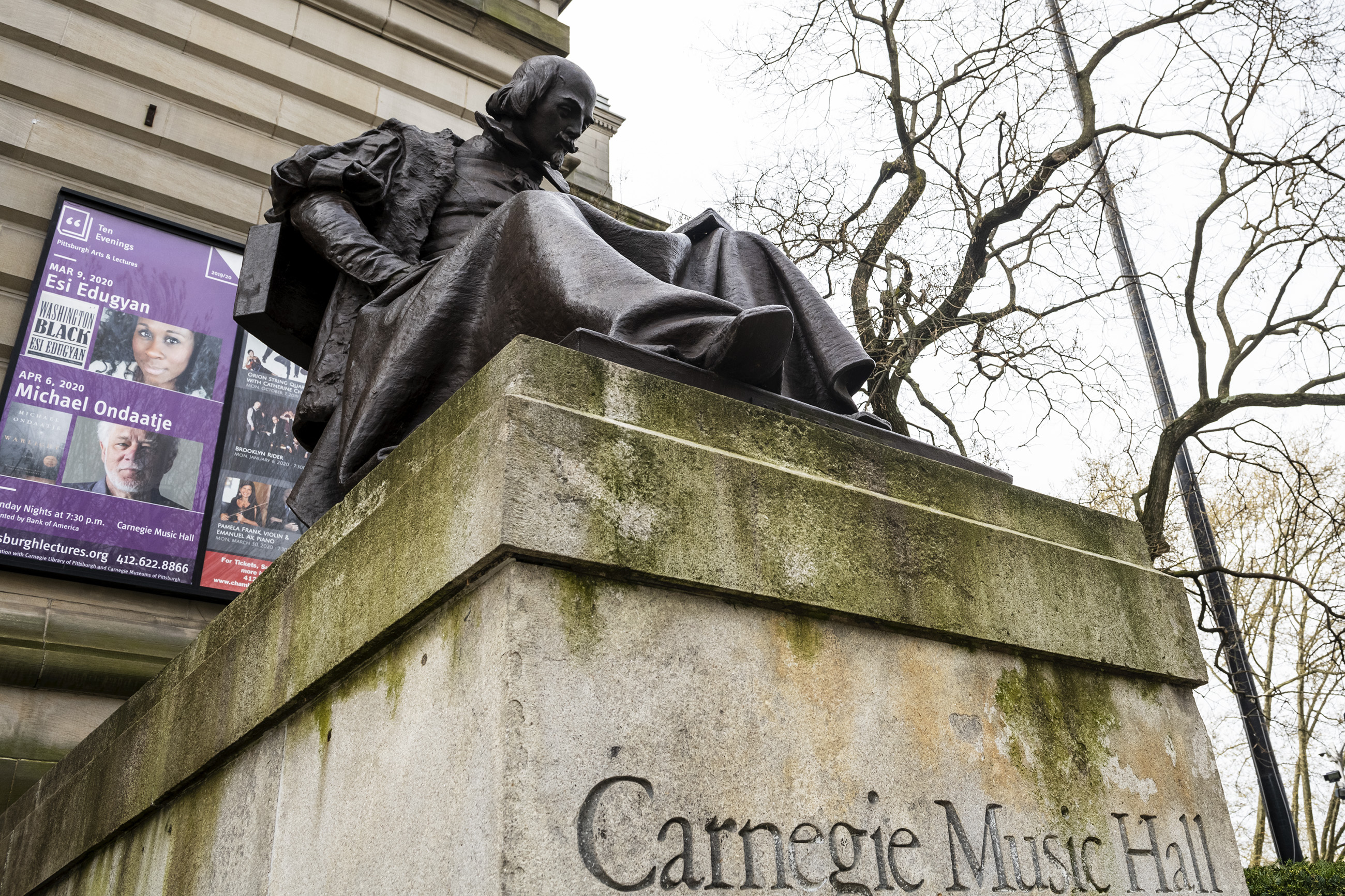
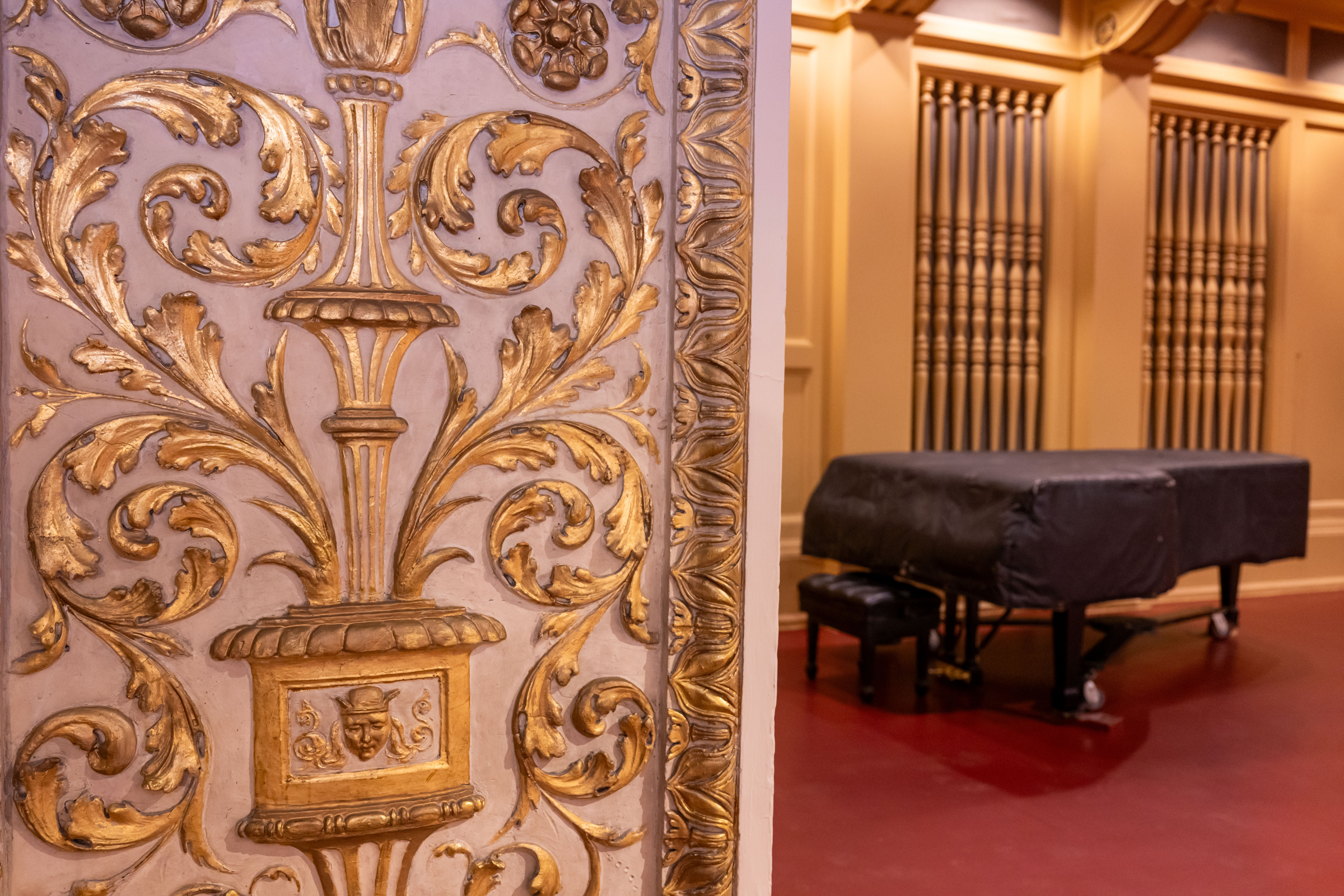
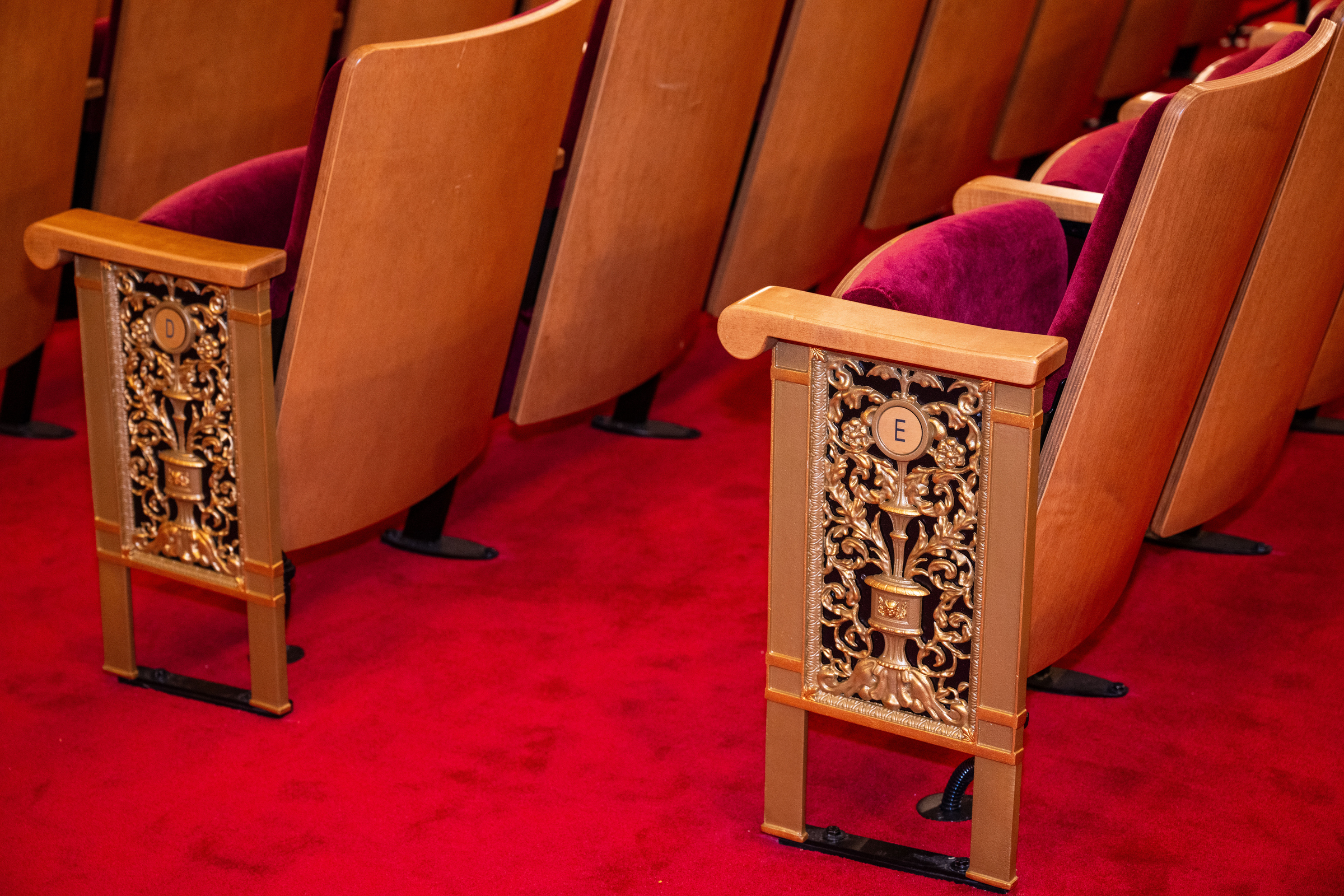
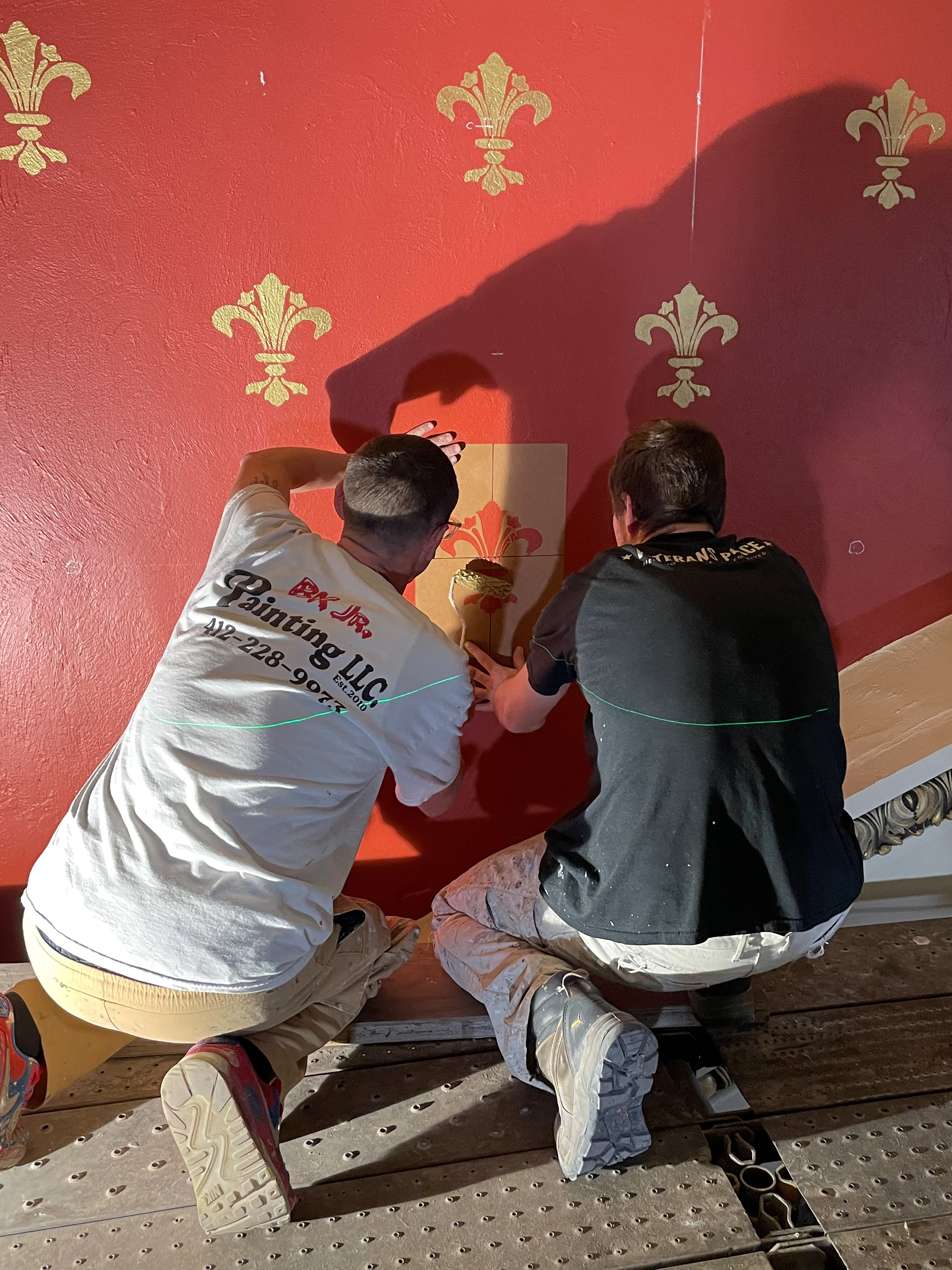
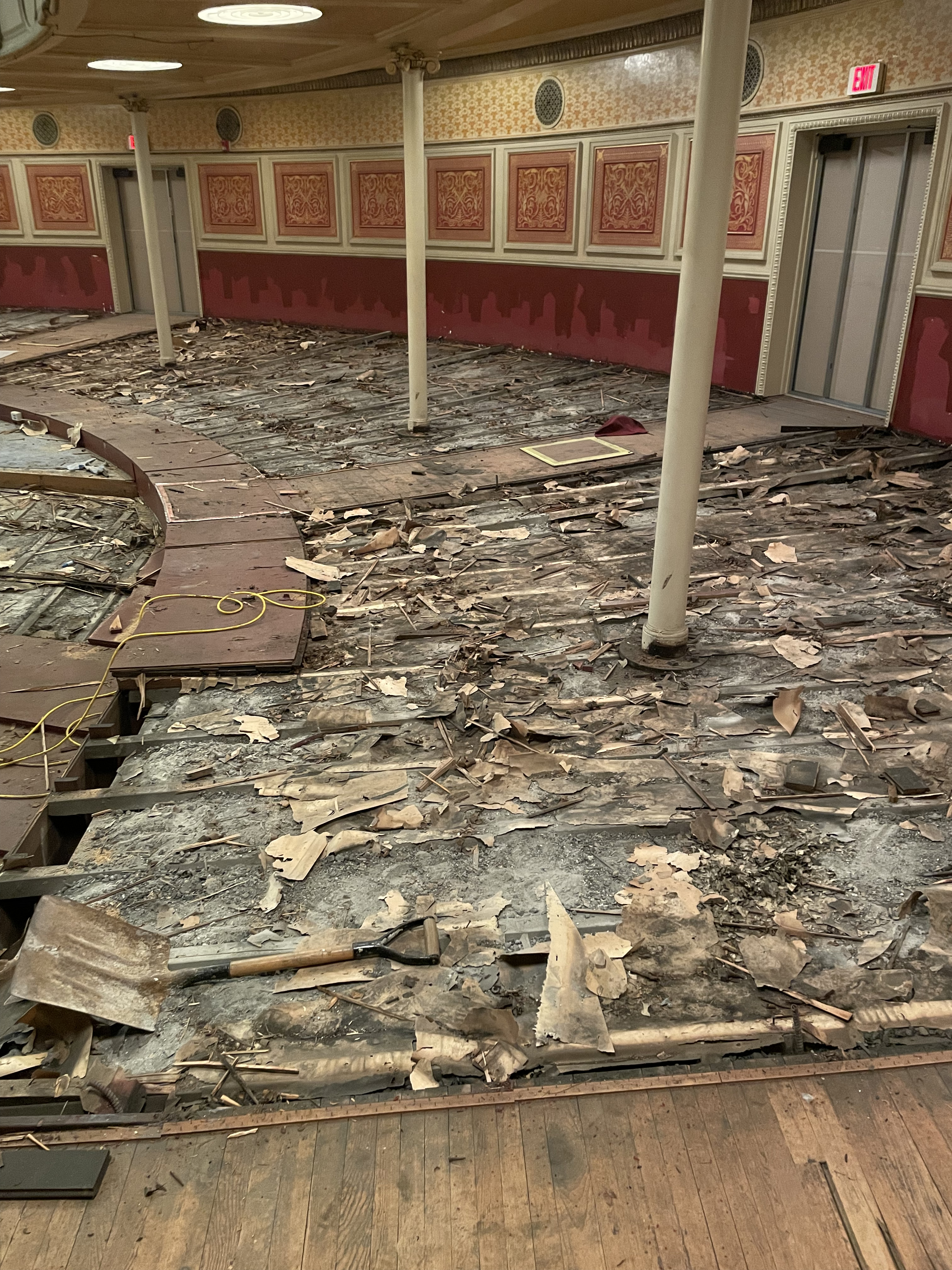
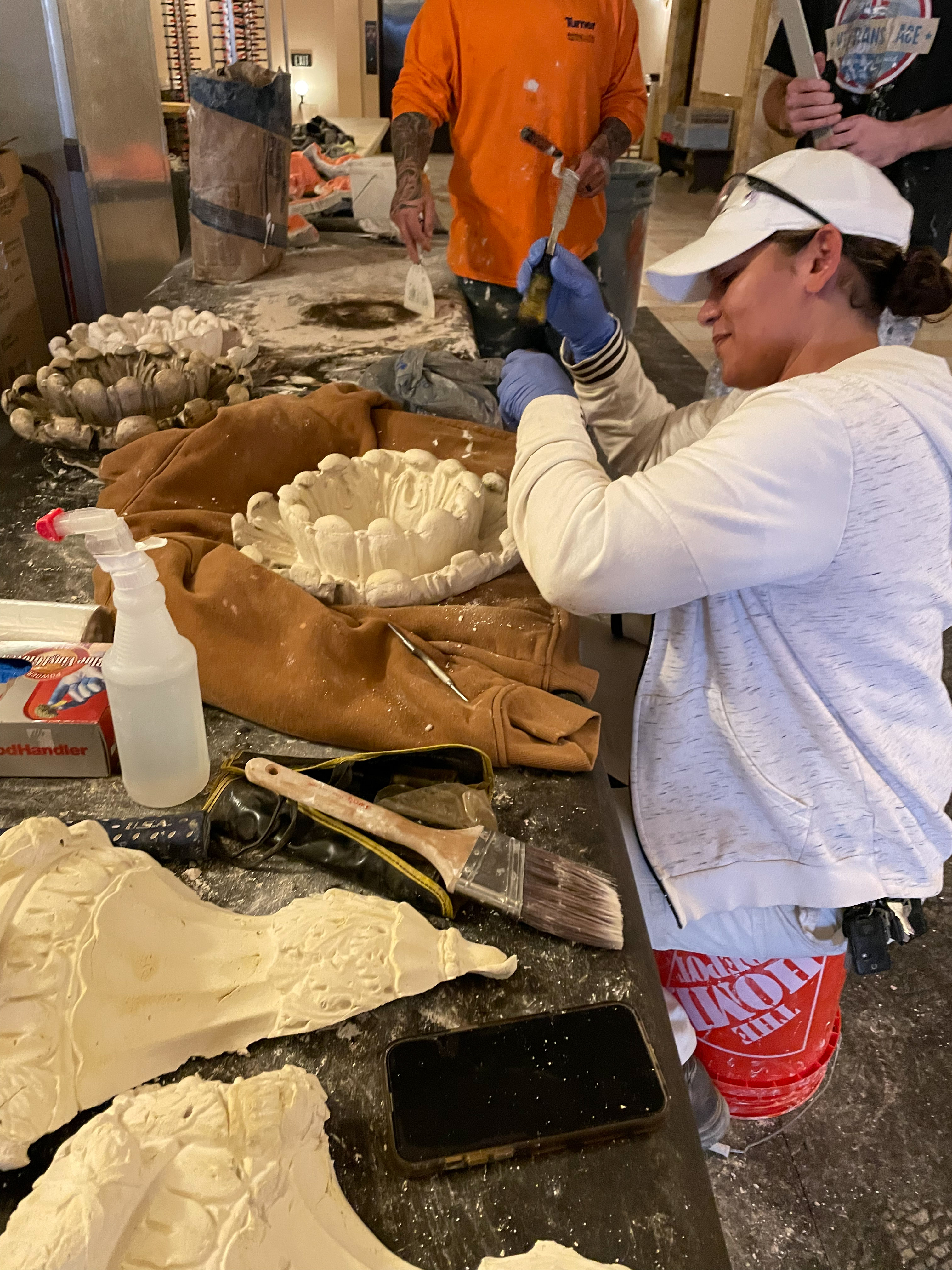
“The building has slowly grown over the years,” Simonetti said.
As it’s grown, the hall has accumulated its share of ghost stories as well.
A judge hanged himself in the library stacks in the 19th century and, according to the Carnegie Library website, writing occasionally appears where he secured the noose, high above where any human could reach without assistance. Security footage often flickers for no explainable reason, and multiple independent accounts of a little girl in a communion dress wandering backstage have surfaced.
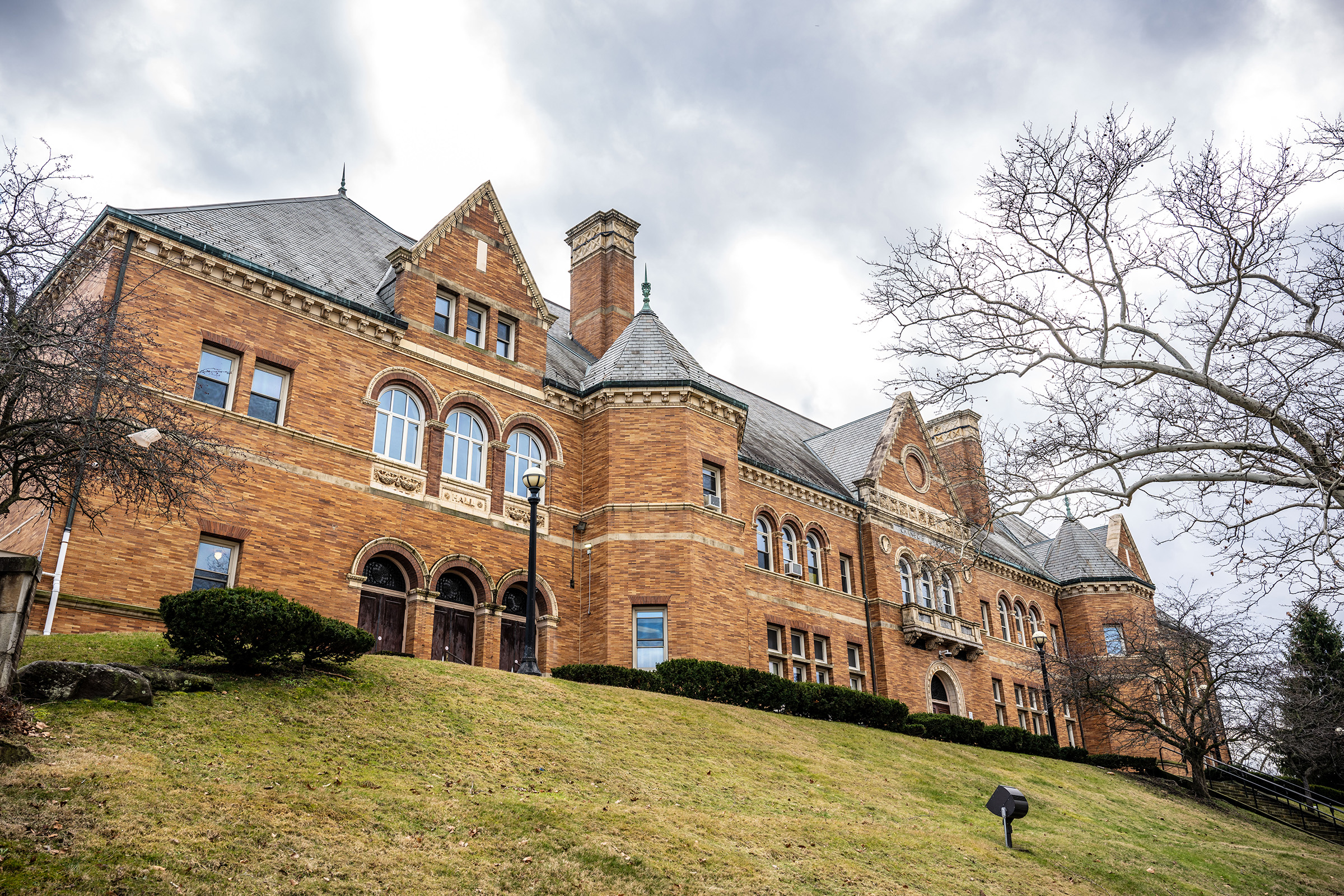
Who’s haunting the Carnegie Music Hall in Homestead?
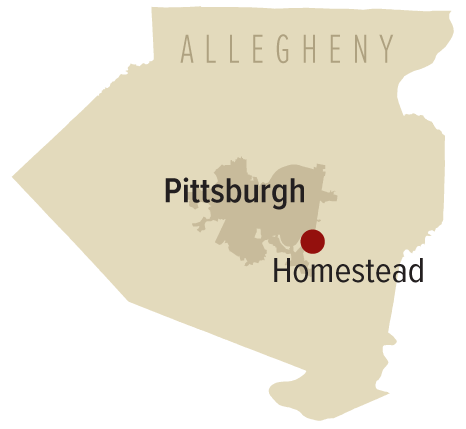
There are tales of locked cabinets opening themselves in dark rooms, of a young boy’s laughter floating from lockers in the gymnasium, of books falling off the shelves for no reason and inexplicable shadows moving about the music hall.
Year completed: 1898
Architect: Frank Alden and Alfred Harlow
Original cost: $250,000
Historic landmark: Yes
Seating capacity: 1,098
Rentable: Yes
Types of events: Concerts, theater, comedy, other
Organ: Removed
Liquor license: Yes
Air conditioning: Yes
“The professional mediums think it might be spirits who don’t think Carnegie would approve of the rock ’n’ roll concerts here,” said Carol Shrieve, executive director of Carnegie of Homestead. Carnegie’s musical preferences are well documented — a 1905 New York Times article details how the steel magnate paid one of the greatest organists in the country to play classical music at 7 a.m. to function as an alarm clock and wake him gently from slumber.
The Homestead Carnegie, technically located in Munhall, is a massive stone structure that houses a library, gymnasium and music hall. Its bones alone are imposing, and the maze-like passageways between each section of the building are dim and bewildering.
In the music hall, plaster hangs from the walls, and the carpets and curtains have faded from bright hues to comfortable, mature shades.
Carnegie donated $250,000 to build the facility, which sits on a hill overlooking the site of an acrid 1892 labor battle. During the famous “Homestead strike,” striking union workers clashed with Pinkerton agents, members of a shadowy private security firm often contracted to infiltrate and break unions. Even though striking union members defeated the Pinkerton agents in that particular battle, they ultimately saw a significant setback to unionizing steelworkers at the turn of the century.
Sixteen people died in the clash. Perhaps their spirits still linger. There’s been enough paranormal activity to bring professional ghost busters, including the ones from the television show “Ghost Hunters” in 2011. There have been amateur spectrologist visits and overnight lock-ins on Halloween, as hall managers capitalize on the building’s creep factor.
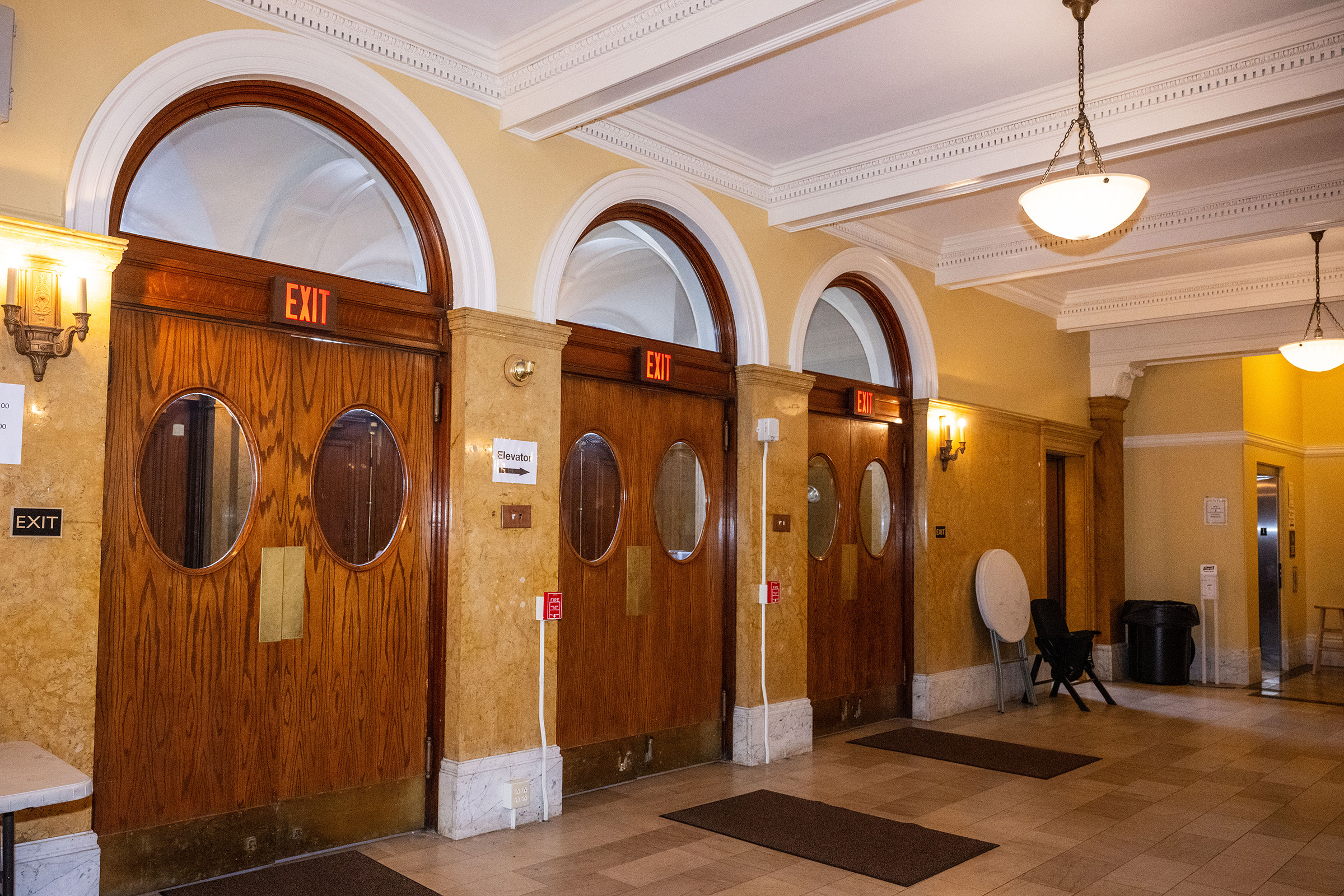
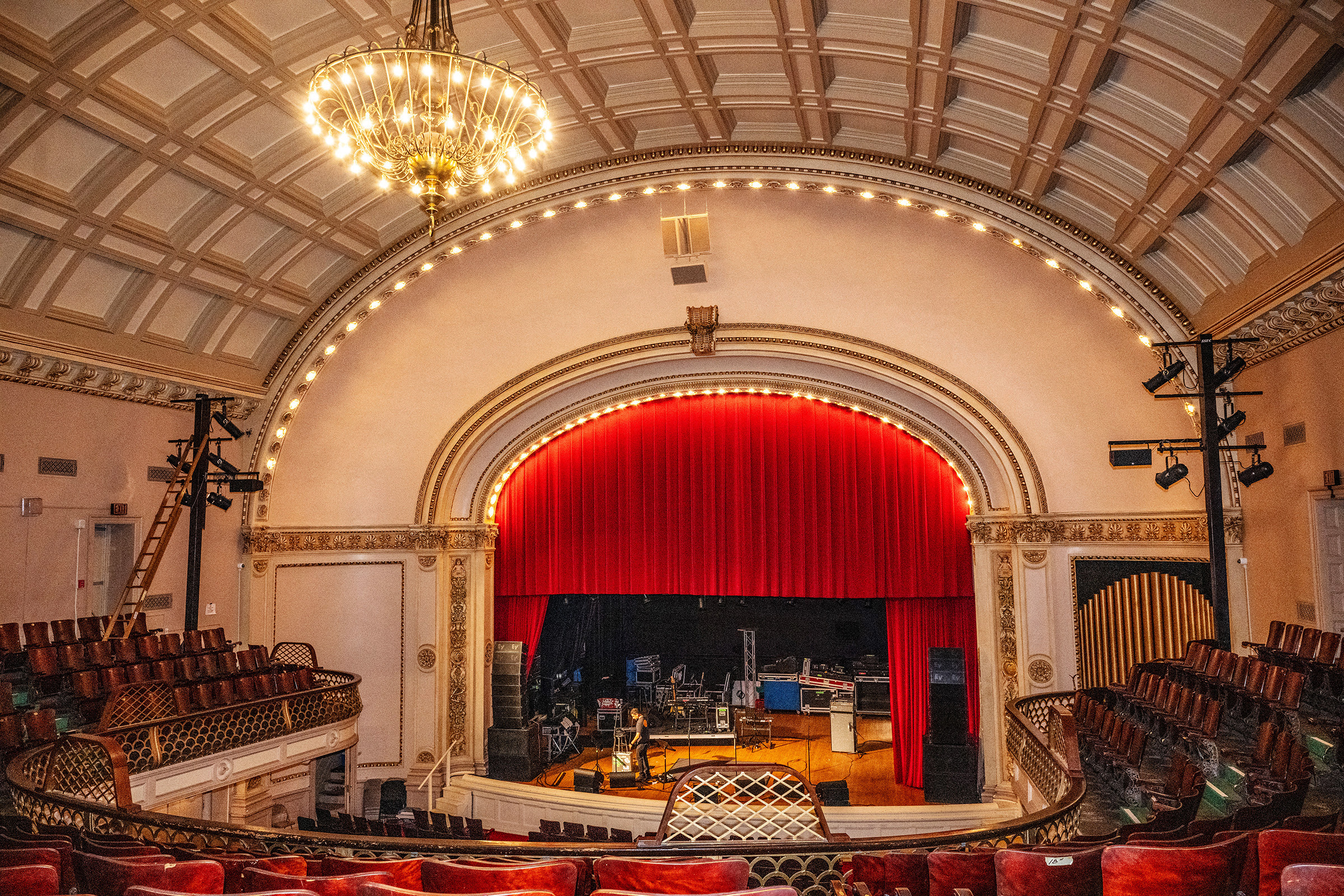
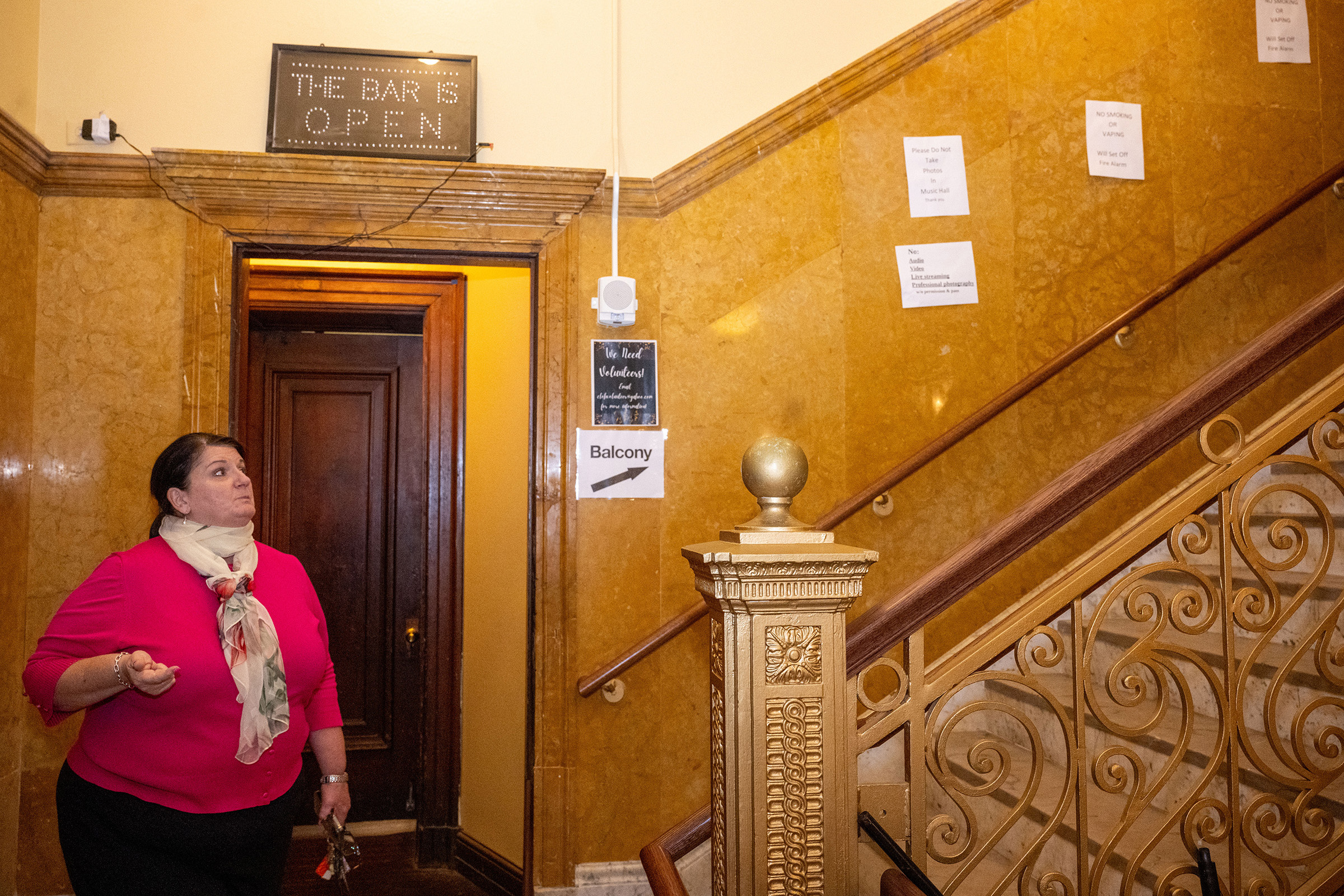
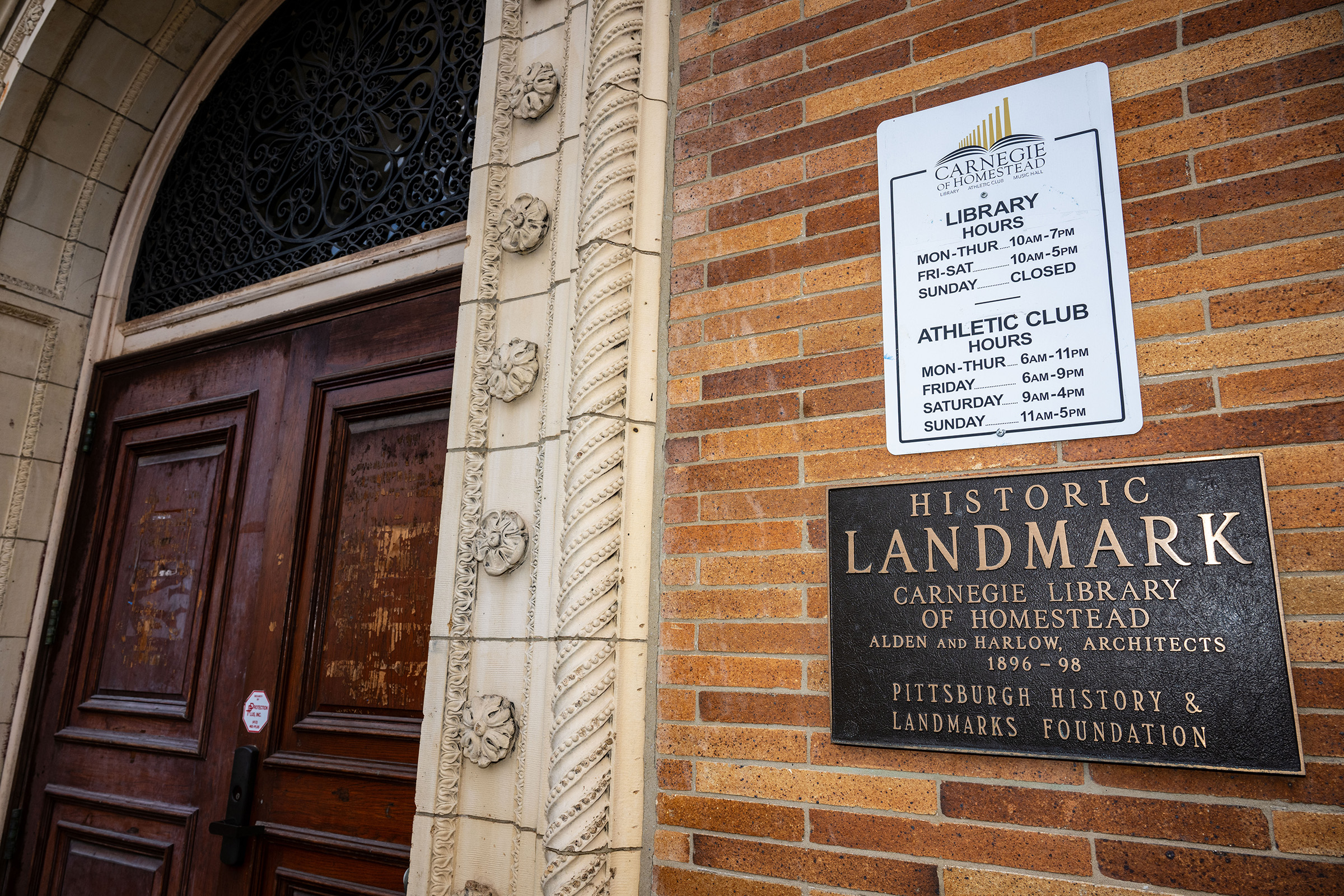
The borough of Homestead comes with a familiar steel town tale: 100 years ago its population was around 20,000, but the Homestead Steel Works closed shop in the 1980s, around the same time as the hall’s pipe organ. Once a glorious instrument played regularly, it was cut out to make room for an electrical generator. (The symbolism is uncanny.) The borough’s population is now tallied at fewer than 3,000 residents.
“We’re going to be the next Lawrenceville,” predicted Shrieve, a long-term resident who believes Homestead is poised to be the next “it” suburb.
Perhaps she’s right. The Homestead hall, which has an active liquor license, is one of the more lively Carnegie Halls in the region. Local promoter Drusky Entertainment manages the space and brings a variety of events including concerts, comedy and magic shows, church plays and naturalization ceremonies. Musical acts ranging from the swing band The Brian Setzer Orchestra to the contemporary Christian songwriter Amy Grant regularly pop in and sell out the hall.
“We aren’t classical organ music anymore, but we don’t bring hard Gothic rock or mosh pit music to Carnegie Hall, either,” Shrieve said.
Roadies from several of these different shows have reported stories of strange happenings and bumps in the night.
The hall is a nonprofit with a budget of about $2.3 million, nearly half of which comes from rental fees. This is a much higher percentage than the other halls. The city and donors have poured millions into the building in recent decades to make it ADA compliant, and the next project is replacing the chairs, many of which have seat numbers written in Sharpie on duct tape. The hall is actually selling off these original 1898 seats this summer to help raise the requisite $300,000.
It still needs acoustic treatments, an additional air conditioning unit and energy-efficient lighting to continue modernizing.
“I’m still out here shaking a tin cup!” Shrieve said.
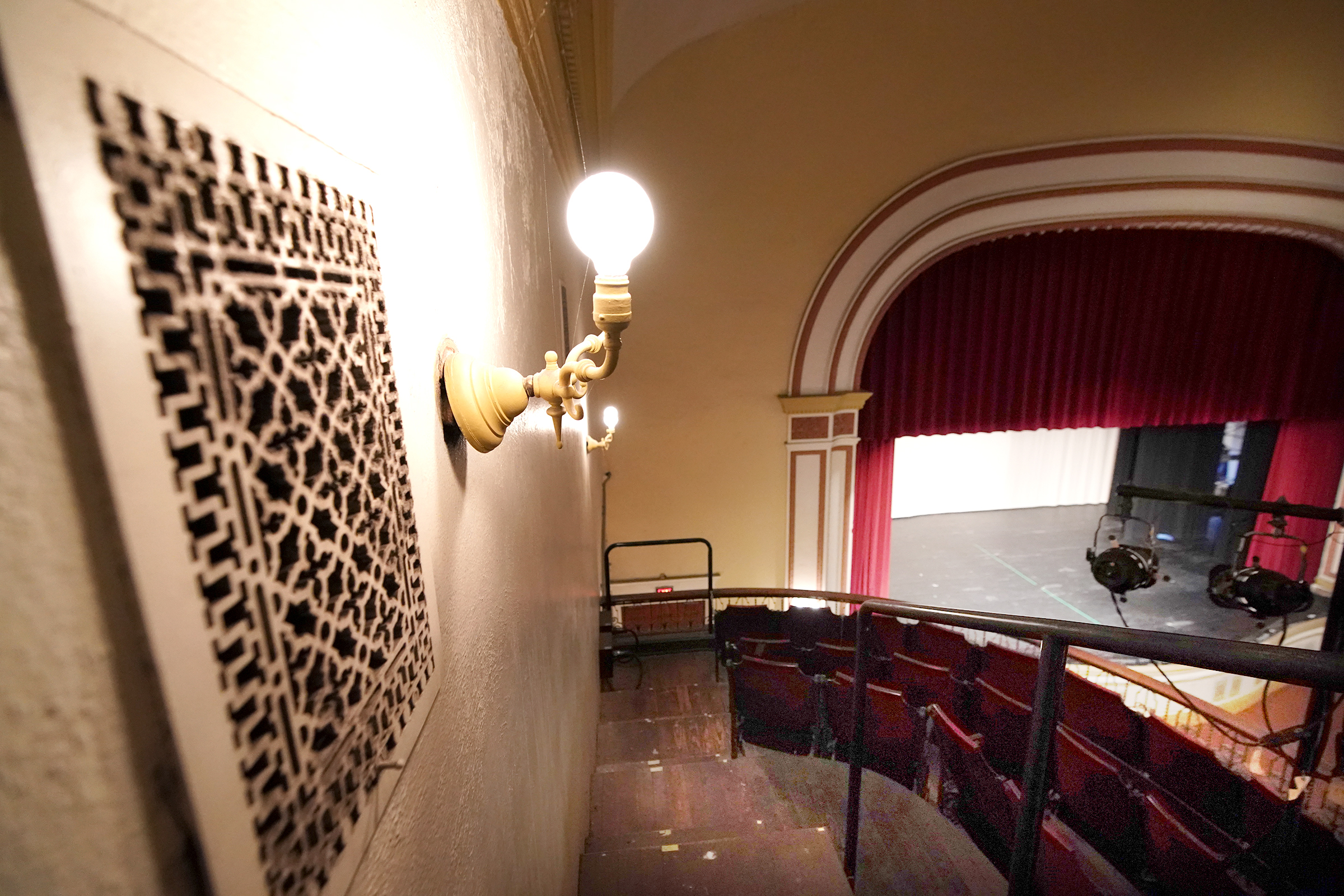
The music hall in Carnegie was built as a result of a deal brokered by politicians and the hall’s namesake tycoon.
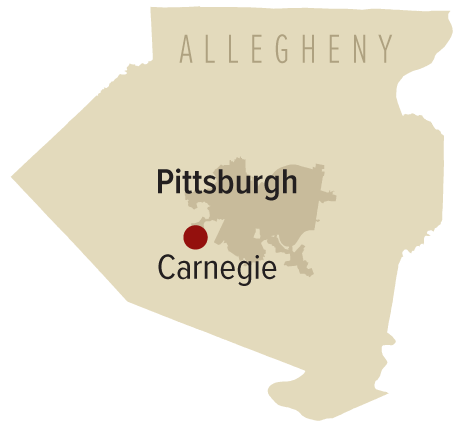
When the small Pittsburgh boroughs of Chartiers and Mansfield merged in 1894, their leaders made a pilgrimage to see the great Andrew Carnegie in New York City, pledging to name the new town after the steel baron if he’d make a donation. Carnegie agreed and sent a check for $20,000 for the new town to build a combined library, gymnasium and music hall that would function as a community center for learning and art and health.
Year completed: 1901
Architect: Struthers & Hannah, Dushane & Lewis
Original cost: $244,000
Historic landmark: Yes
Seating capacity: 400
Rentable: Yes
Types of events: Concerts, theater, comedy, other
Organ: No
Liquor license: No
Air conditioning: No
He still feigned shock at the borough’s dedication, stating publicly that it came “much to the surprise of Mrs. Carnegie and myself, but I will not deny also, much to our satisfaction.”
Construction on the building, which like most of his other halls sits atop a hill to survey the town with majesty, wrapped in 1901.
This is the Carnegie Hall in Carnegie, a delicate, 400-seat hall with extraordinary, resonant acoustics. Even the sound of a distant train whistle blooms slightly in the hall, lighting up the space with a colorful warmth. It’s an intimate hall ideal for chamber music with small groups of musicians or small theatrical productions, as only a few dozen artists can fit on stage at any one time. Pittsburgh ensembles, including the early music ensemble Chatham Baroque, the opera company Resonance Works and others have performed in the hall in recent years.
For all its acoustic beauty, this once-ornate hall is deteriorating, with water damage and plaster separating and hanging off the wall and ceiling in numerous spots. Some of the marquee light fixtures around the stage are burnt out, other fixtures are exposed. In places, the water damage has caused the plaster to separate and droop.
It’s still possible to see the hall for the decadent space that it was and could be again, but much work is needed.
This is after donors and local government have poured more than $15 million into the library since 2004 to help weatherproof and shore up the structure, make it accessible and add partial air conditioning. (It’s worth noting the music hall’s chairs are quite comfy.)
“Another million will probably get us air conditioning,” said Marlee Gallagher, executive director of the Andrew Carnegie Free Library and Music Hall.
The borough of Carnegie has a population of around 8,000 and is a “distressed community,” according to Gallagher. It’s another steel town that saw a steep decline after the closure of Superior Steel and Union Electric Steel in the 1970s.
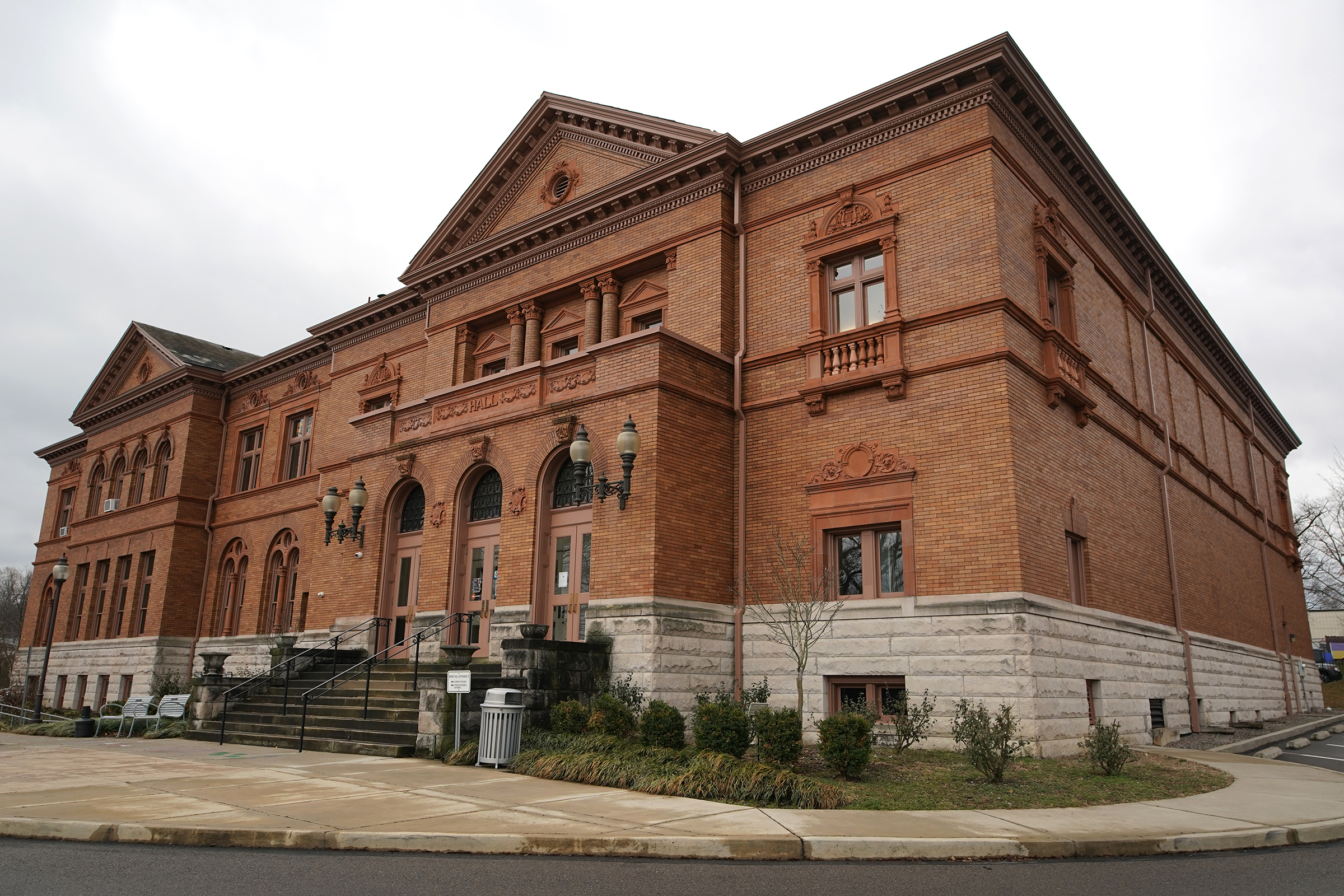
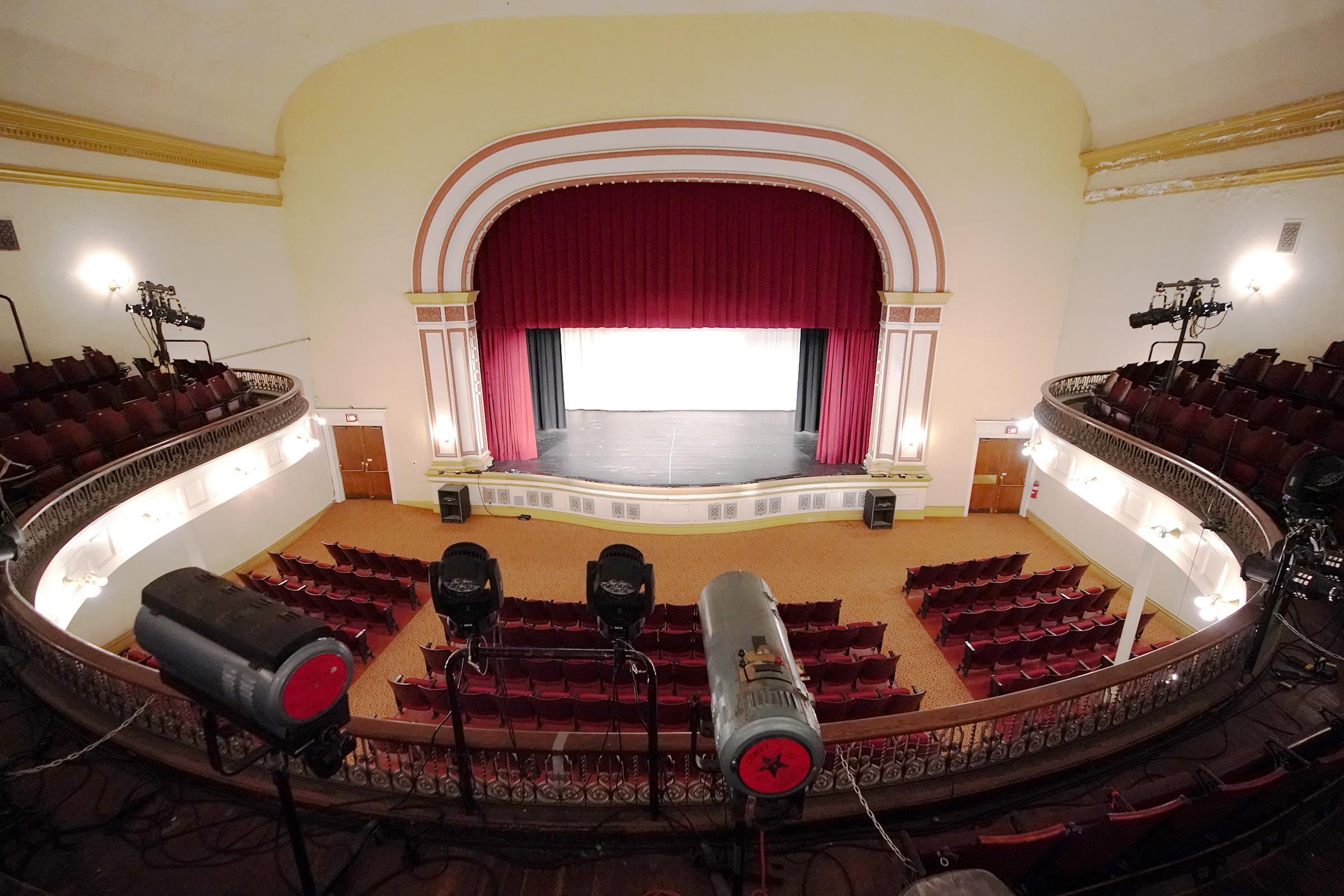
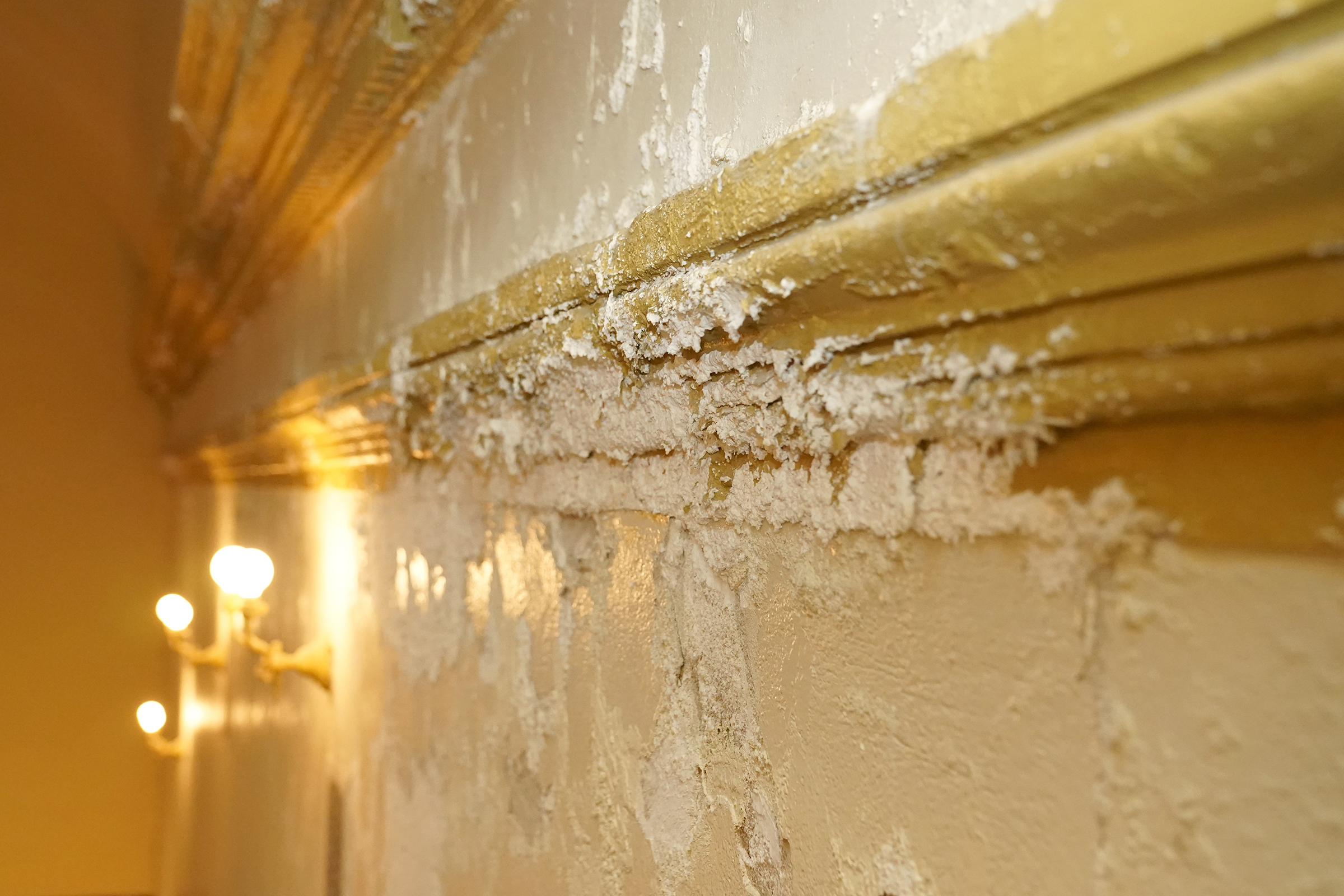
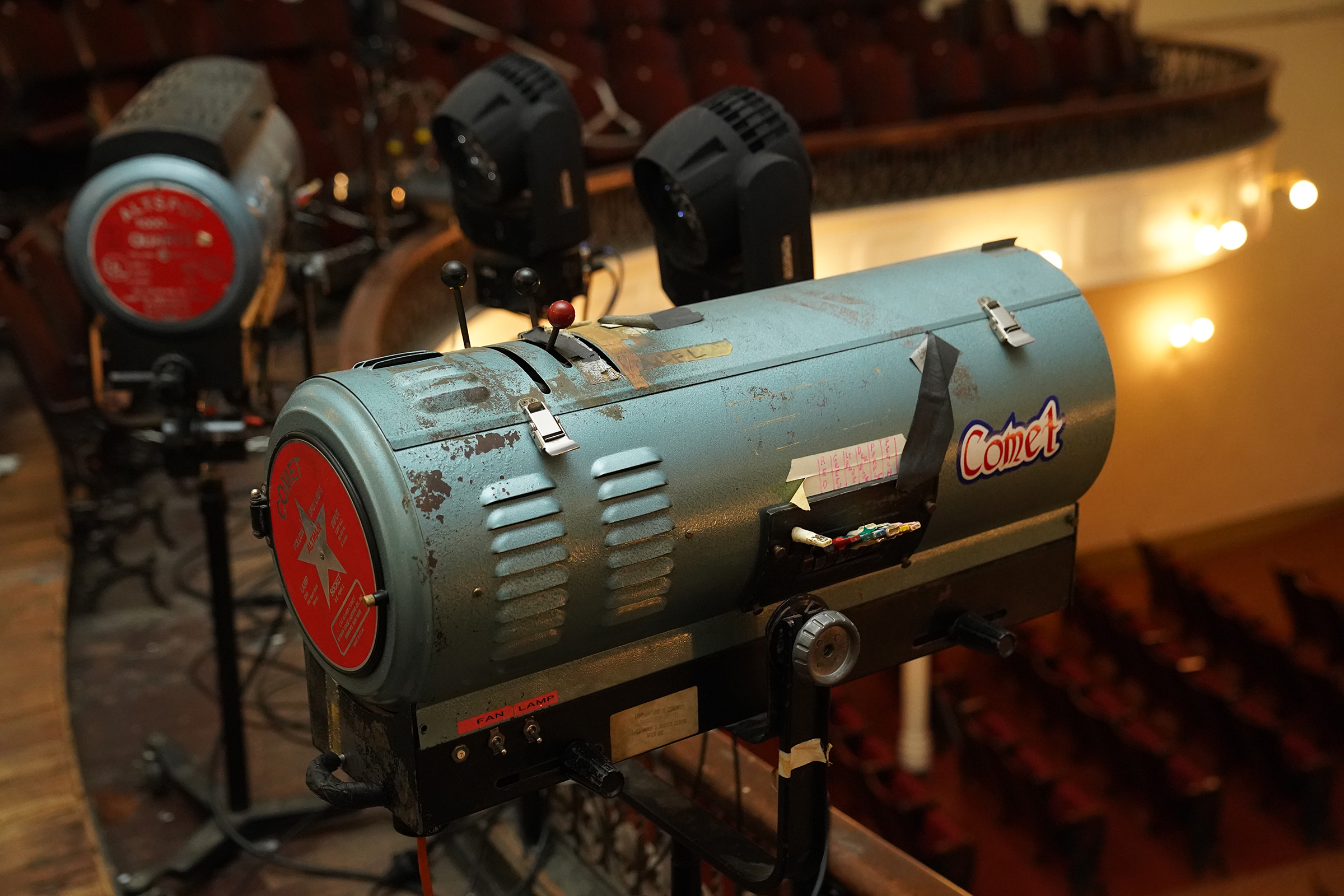
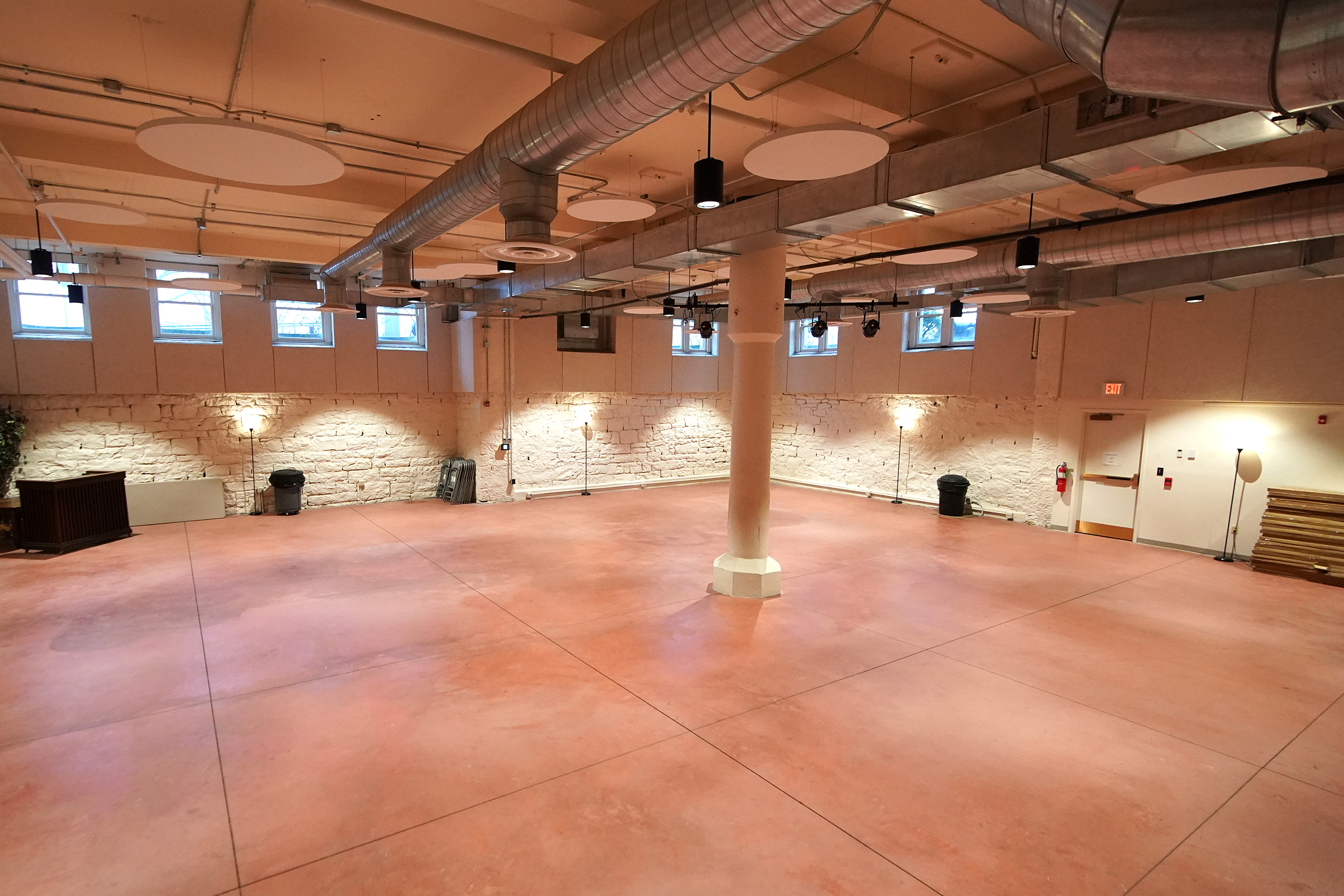
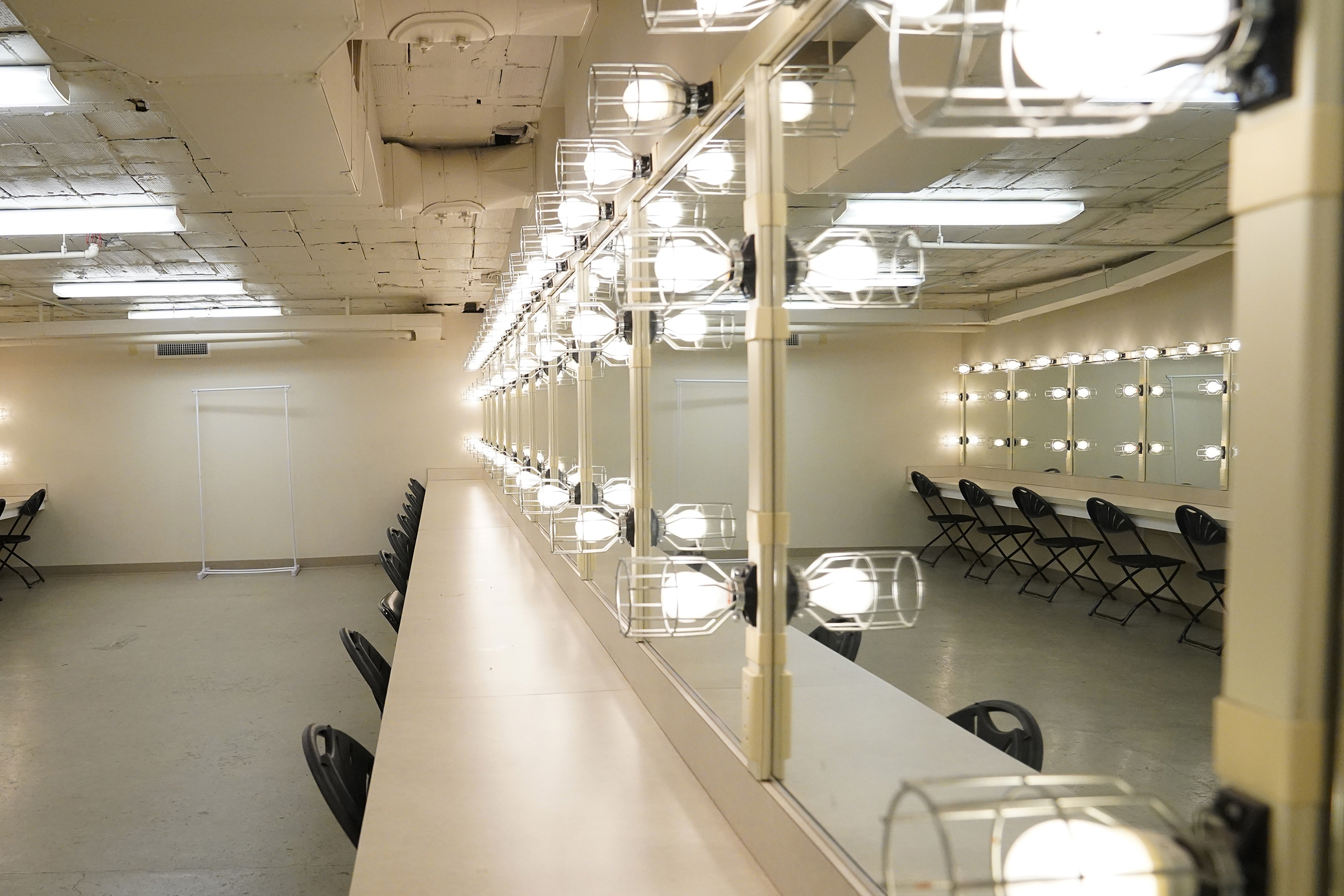
Today, the music hall is only operable from around October to June. The lack of central air means it’s too hot and stuffy for performances by local classical music and theatrical groups during the warmer months. (It also hosts film screenings and occasional paranormal events. This hall is said to be quite haunted as well, with some of the “supernatural” activity allegedly caught on camera including a mysterious, humanoid shadow appearing on film with no one there to cast it.)
Next will be roof and cosmetic repairs.
Carnegie set up most of his libraries and music halls to be funded through local taxes, declaring that such institutions were “scarcely worth maintaining unless the community appreciates it sufficiently to tax itself for maintenance.” But he made five exceptions out of the 2,500 libraries he established: the halls in Homestead, Braddock, Duquesne, his hometown of Dunfermline, Scotland, and in Carnegie itself. There, he donated extra funds — $40,000 in Carnegie — to establish an endowment.
“We keep our rates pretty low, but prices will increase after the renovation,” said Heidi Matthews, director of the music hall, noting that the hall’s budget is around $650,000 currently.
Gallagher said the plan is to raise the funds to install air conditioning by next summer.
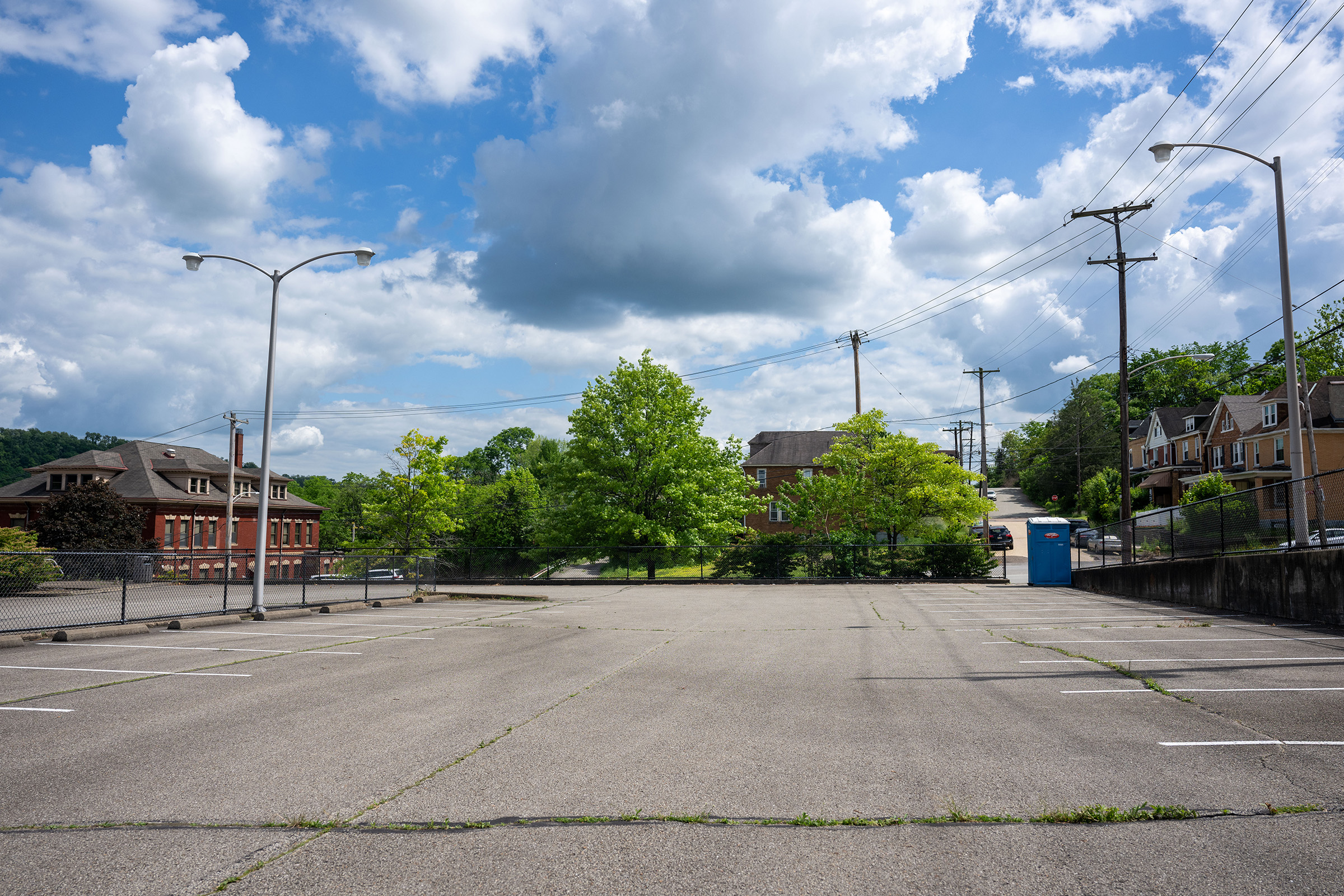
There’s no longer a library at “Library Place” in the small city of Duquesne. Instead, a baker’s dozen of houses occupies the property where once loomed a grand, castle-like library, gymnasium and music hall — the final Carnegie Music Hall built in the United States.
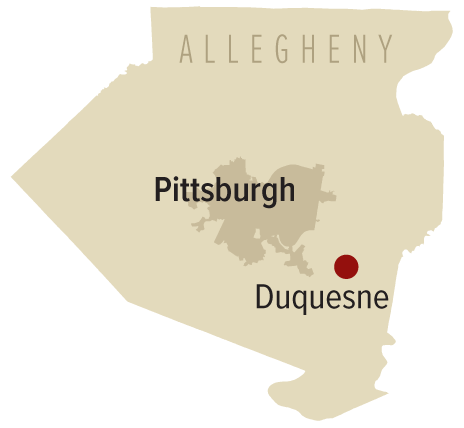
Now, it only exists in records and historic photos.
Year completed: 1904; demolished 1968
Architect: Alden and Harlow
Original cost: $256,000
Historic landmark: No
Funding issues threatened almost all of Pittsburgh’s original Carnegie Halls in the latter half of the 20th century. The hall in Duquesne — once an imposing structure about 12 miles south of Pittsburgh — was torn down in 1968, a travesty for the community and a cautionary tale.
This hall began its life much like the others, as a part of one of Carnegie’s first U.S. libraries. Complete with a gymnasium with a swimming pool, it was also built to serve as a community center in a town largely populated by employees of the Carnegie Steel Company.
Its journey to demolition is one of diminishing funding.
Carnegie set up these early libraries and halls in a couple of different ways. Some local municipalities, including the halls in Oakland and Allegheny, were required to support at least 10% of the library’s operating costs with public funds, a system dubbed “The Carnegie Formula.”
Carnegie’s steel plants provided operating cash to the libraries in Braddock, Duquesne and Homestead. In 1901, He set up an endowment of $1 million to provide for these libraries, to be managed by a board of U.S. Steel officials. They were quite conservative with the endowment, and by 1960 it wasn’t generating enough revenue to cover the costs of all three libraries.
U.S. Steel sold the Braddock and Duquesne libraries to their respective local school districts in the 1960s for $1 each.
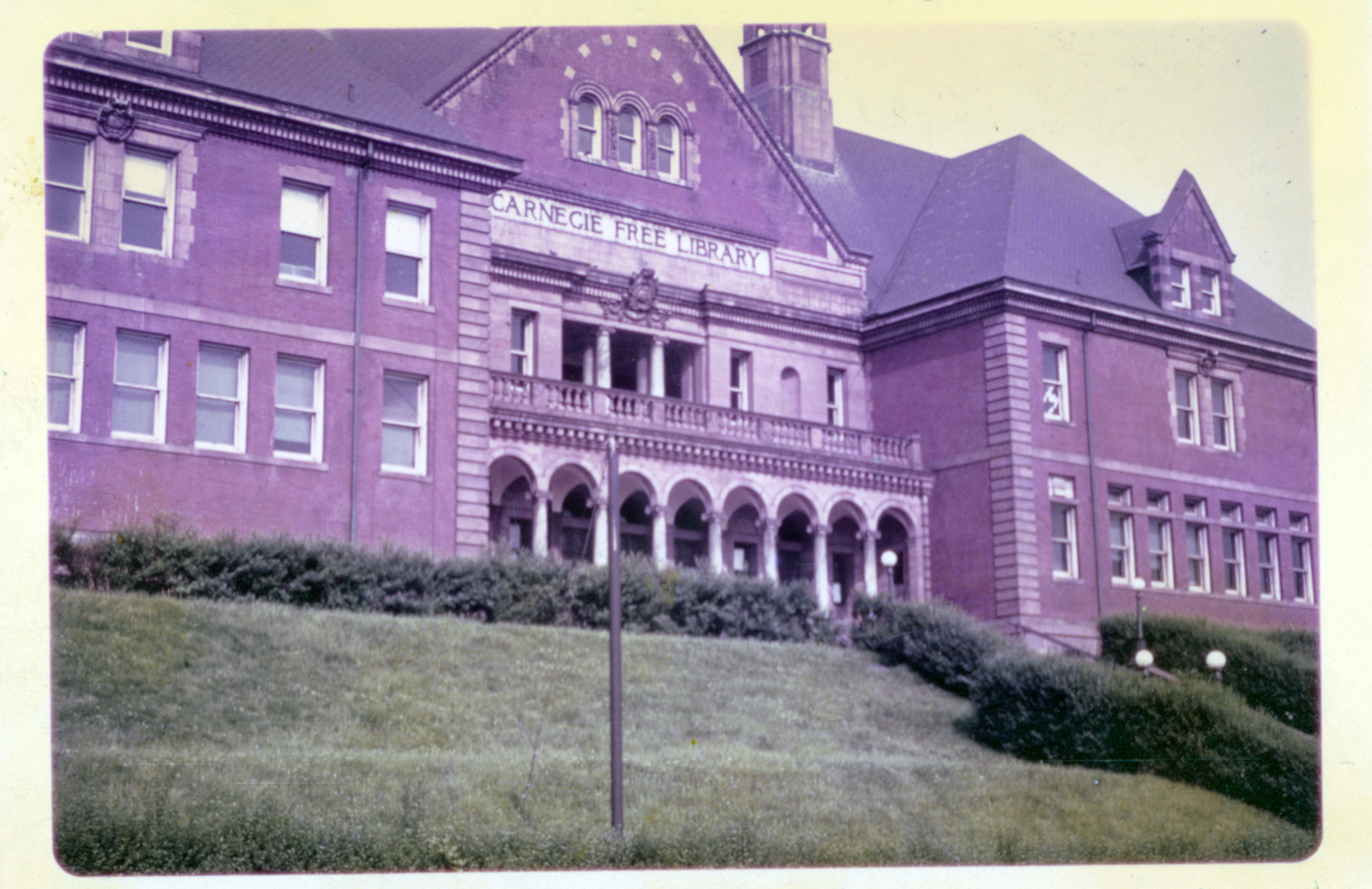
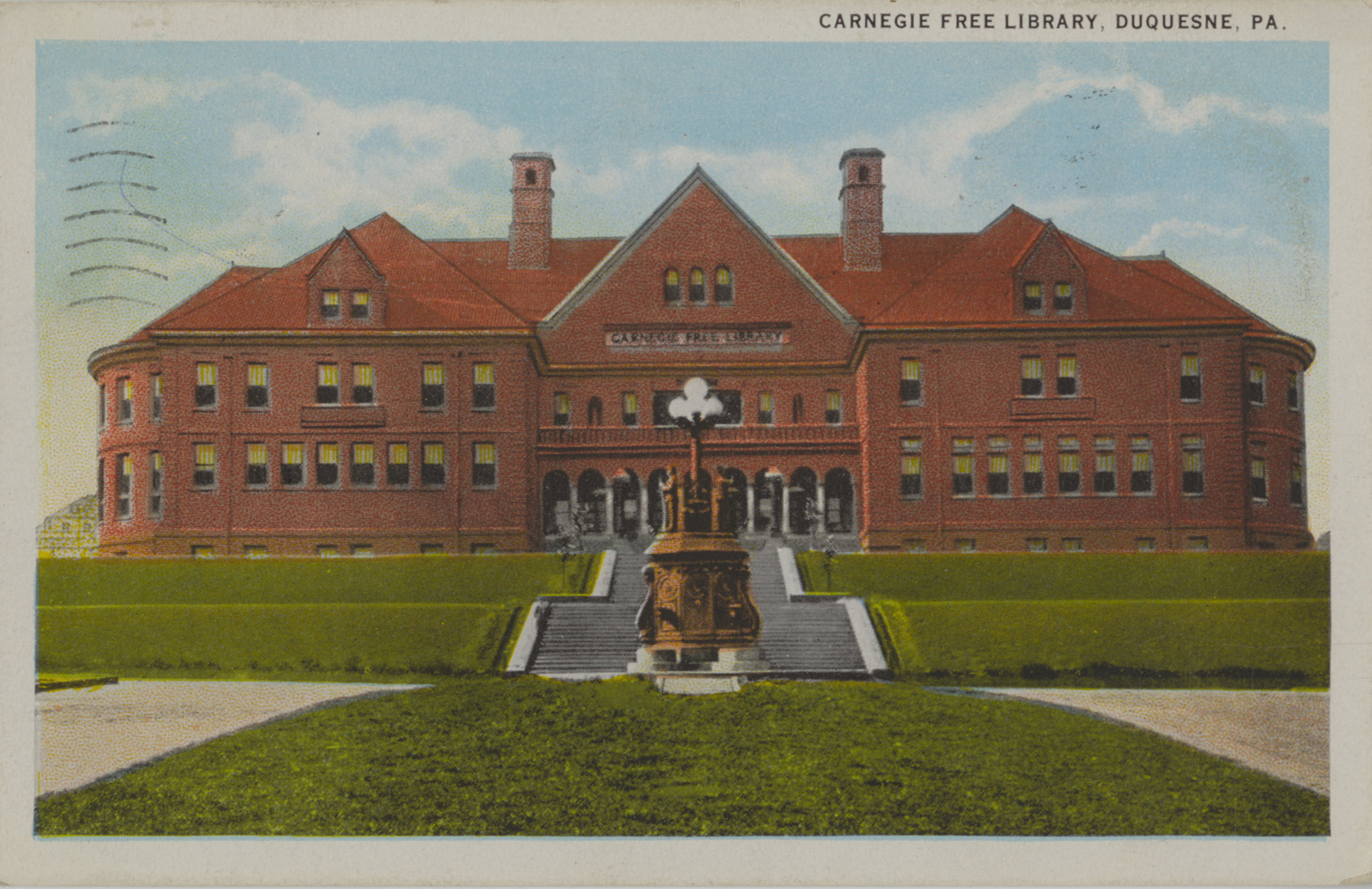
The Duquesne City School District tore its library down in the summer of 1968 to create space for a new gymnasium, but almost immediately dropped the project due to the fact that building such an annex would result in a partial loss of state funding, the Post-Gazette reported in 2006.
The Braddock Carnegie Library is operational again and in the process of renovating and reopening. But because it was sold, only the Homestead library has legal claim to the endowment now valued at about $1.8 million. It’s a fact that rankles somewhat in Braddock.
Today, the nearby town of McKeesport operates a library branch in Duquesne, actually housed in the city’s former high school building. It’s only open a few hours a day and is closed on weekends.
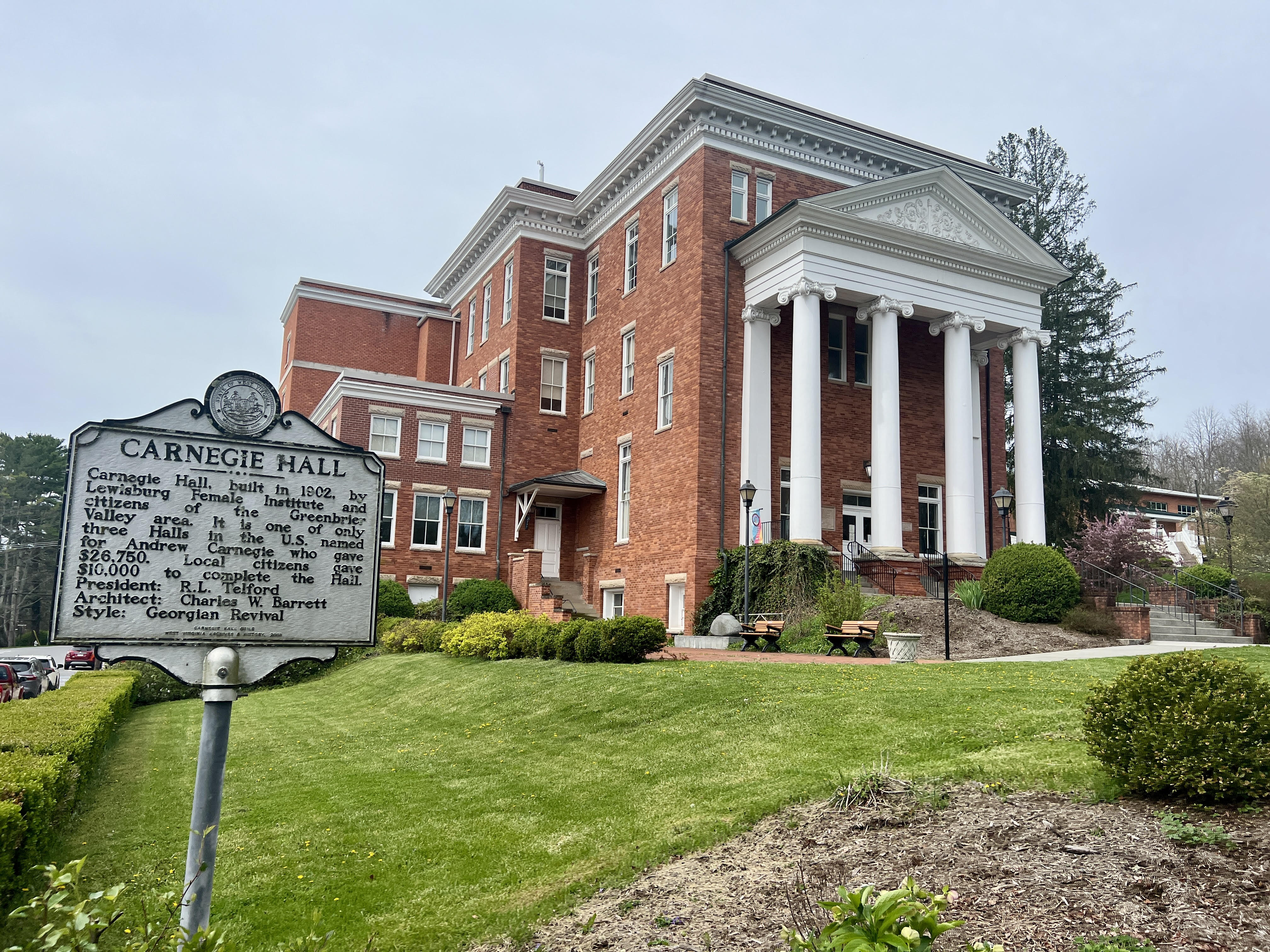
Carnegie’s last two music halls aren’t in New York City or Pittsburgh at all, but in Scotland and, of all places, West Virginia. The Scotland Hall was built in Dunfermline, Carnegie’s birthplace, in 1937, long after its namesake’s death, as an addition to the world’s first Carnegie Library.
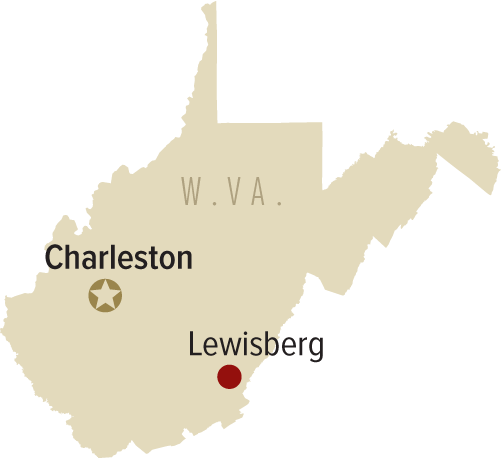
The final Carnegie halls in the United States came about because of a terrible fire.
Year completed: 1902
Architect: Charles W. Barrett
Carnegie contribution: $26,750
Historic landmark: Yes
Owned by: Carnegie Hall Inc. (Lewisburg)
Seating capacity: 420
Rentable: Yes
Types of events: Concerts, lectures, theater, comedy, other
Organ: No
Liquor license: Yes
Air conditioning: Yes
In 1901, in Lewisburg, W.Va., a women’s college called the Lewisburg Female Institute burned down. College leaders appealed to Andrew Carnegie, a known philanthropist by this time, who pledged $26,750 to rebuild the building if they’d name it after him and if the community could raise $10,000 on its own.
“We said we’d put Carnegie’s name above the front door,” said Philip McLaughlin, a multigenerational Lewisburg resident and marketing director at the town’s Carnegie Hall. “Obviously we didn’t,” he said with a sly smile. (Even though the building is now known as a Carnegie Hall, Carnegie’s name does not actually appear on the building.)
Still, Lewisburg residents coughed up the funds, and a new Carnegie Hall was born, complete with an auditorium for lectures and performances, classroom space, laboratories and studios aplenty. This “hall” is more of a classroom space, but it’s alive today with all manner of community events and classes and performances and more.
Lewisburg, named after one of George Washington’s scouts, isn’t a poor, hollowed out former mining town. It’s in the southeast portion of the state, about a four-hour drive from Pittsburgh, in Greenbrier County, the second largest in West Virginia. Its main drag is populated with cute cafes, theaters and restaurants, as well as an abundance of cemeteries and churches. Architecture is boxy and Germanic. Its population is nearly 4,000.
“We’re a perfect storm here, a real diamond in the rough,” said McLaughlin. “There’s all this old farm money, and I mean serious money, flowing in the area. We’ve got great hospitals, sporting clubs, the state fair — we’re a real hotbed.”
Like its sister halls in the Steel City, funding for the college dried up. The building was sold to the state, which turned it into a mental health facility for special needs patients for a time. In the 1980s, the building was nearly demolished, but a group of residents banded together to form Carnegie Hall Inc. in 1983 and repurposed the space as a performance venue, art gallery and arts education center. Residents raised more than $8 million over the next decade to renovate the space and make it more accessible.
Seating purchased from a historic Chicago theater was installed in 2020.
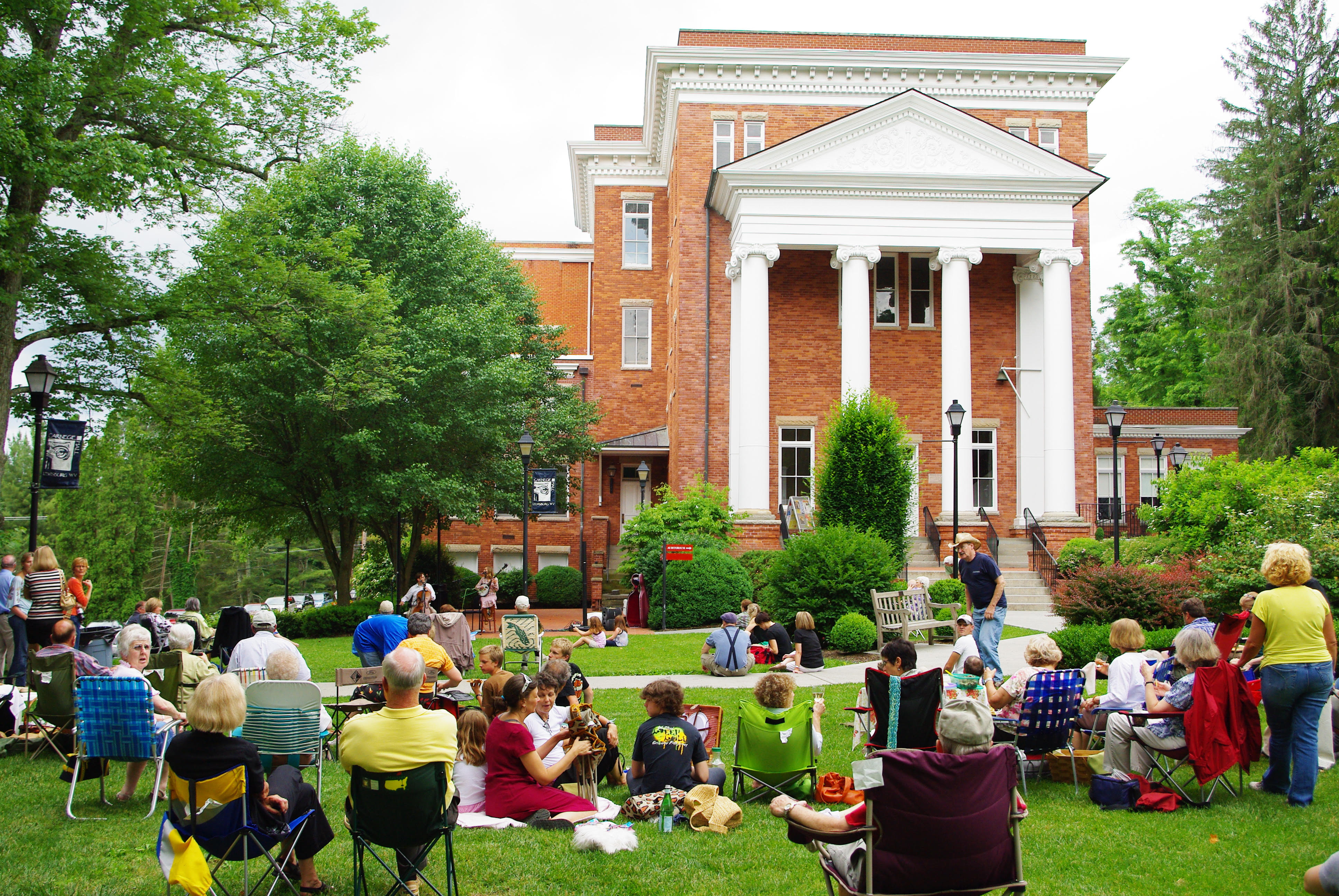
The hall does have a liquor license, but an old West Virginia blue law stipulates that a bar can’t be operated within 50 feet of a church, measuring from front door to front door. Given the number of churches, the town has gotten creative about this — sometimes side doors are labeled “front door” to skirt around the letter of the law.
It’s not a traditional “music hall” like the Pittsburgh halls, but its purpose as a community center is a deliberate homage to Carnegie’s efforts with such facilities. That said, the hall’s claim that it’s “one of four” Carnegie Halls in continuous use isn’t quite correct.
The center operates with a $1.3 million budget and serves more than 75,000 citizens each year. The main auditorium includes a small lobby area that serves as a gallery with works by local artists displayed with price tags. Between the floor and small balcony, the hall seats about 420 — a Steinway piano (provided by a Pittsburgh dealer, it turns out, and tuned by Pittsburgh piano tech David Barr) takes center stage.
“We get some great acts coming through here, but our education department dwarfs what we do onstage,” McLaughlin said.
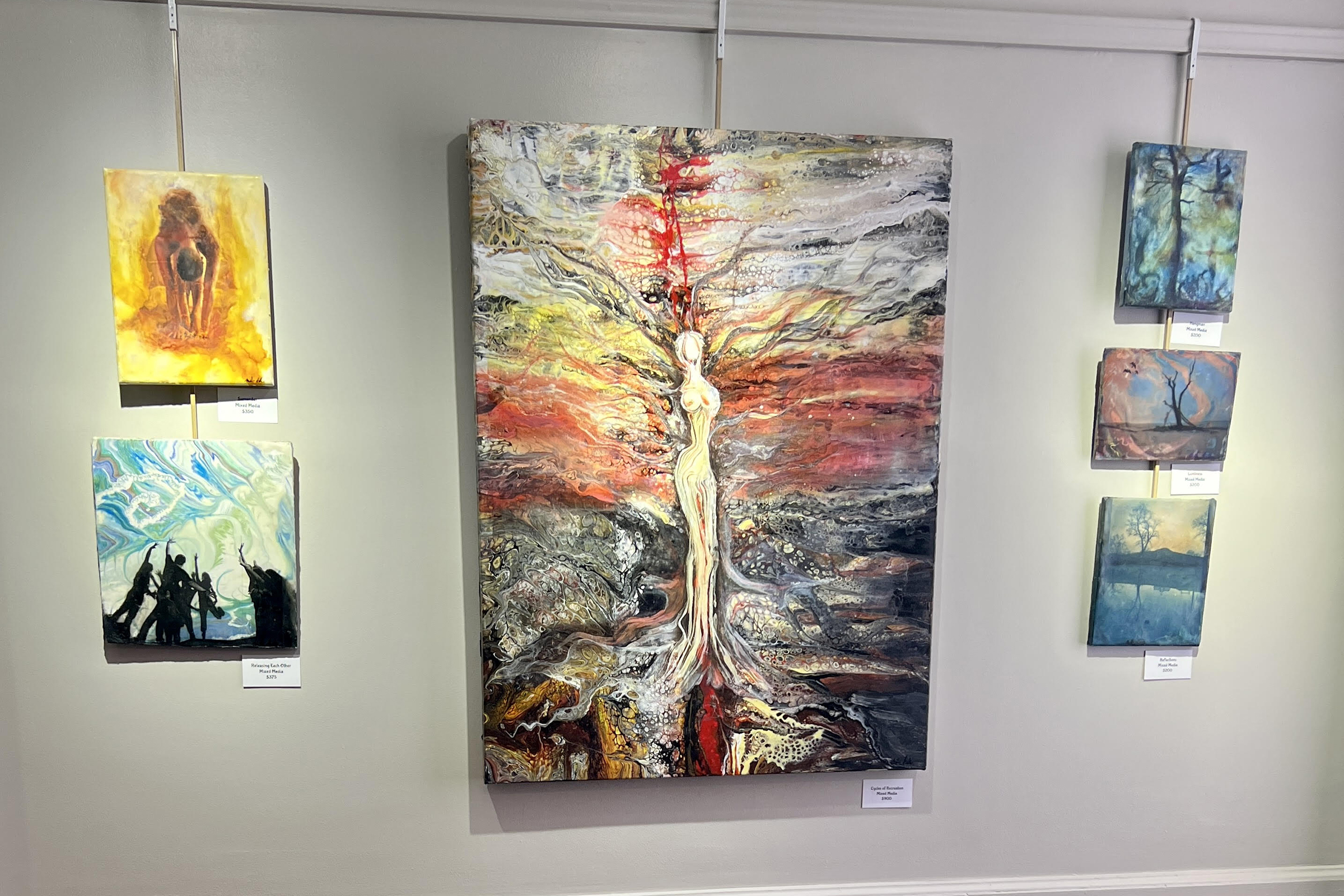
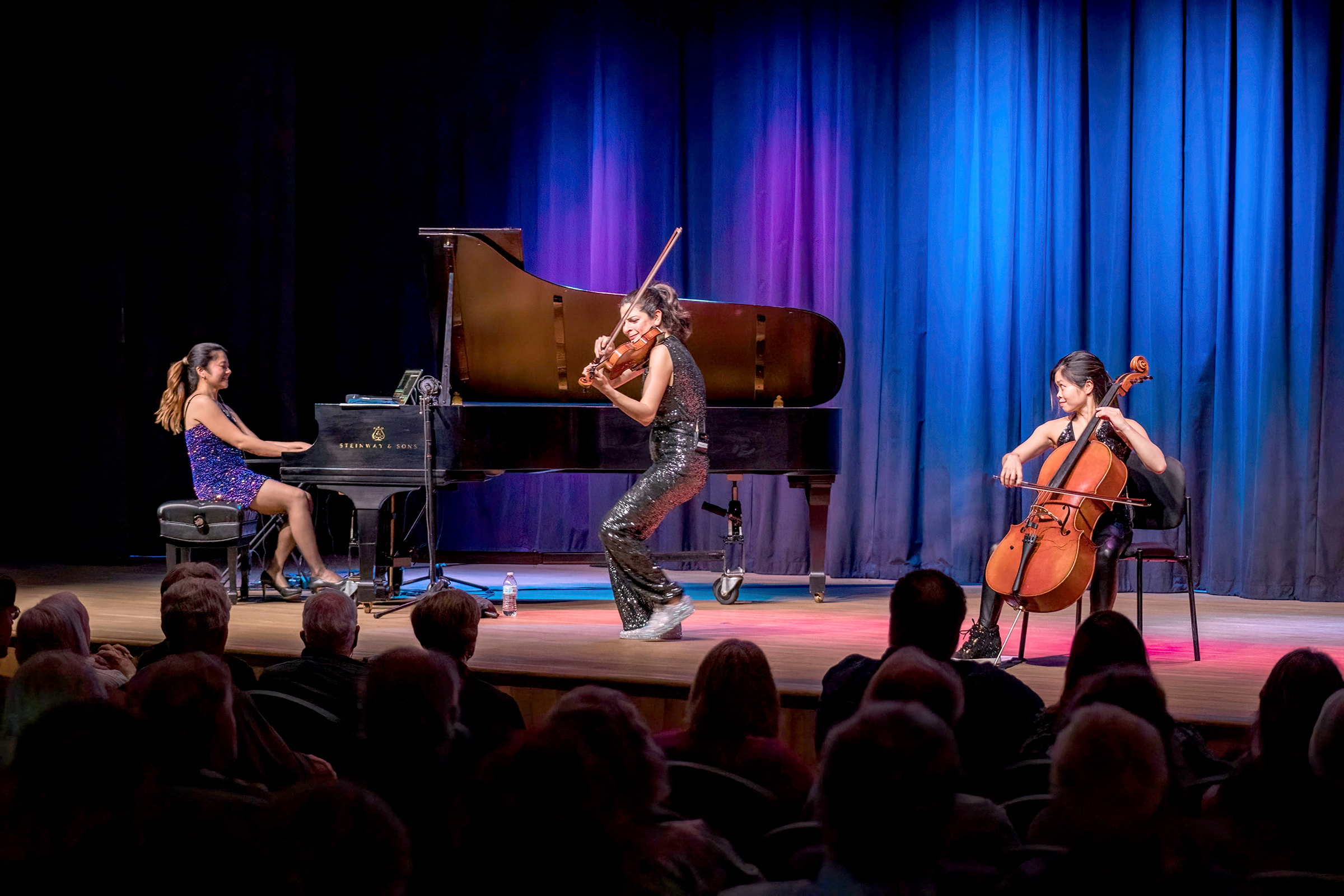
The second floor is mostly classrooms with white boards and linoleum floors, and the guts of the building are filled with the stuff of classrooms — ticking clocks, kilns for ceramics work, materials for weaving and drawing, and more. There’s also a dance studio on the third floor, as well as classes for origami, pinewood derby, basket weaving and other traditional crafts.
Lewisburg is a popular tourist destination for its golf courses, shopping and for the Greenbrier luxury resort, with Carnegie Hall serving as the arts center of the city.
This year, a small bell owned by the family of John Wilbank, who cast Philadelphia’s famous Liberty Bell, was repaired and began ringing again to signal that concerts were starting.
The bell must be rung by hand. The piano is another story.
“Yeah, we’re extremely haunted — more than one person has come in with a story about the piano just starting to play itself,” McLaughlin said. Like its Pittsburgh relatives, the hall comes complete with stories about doors slamming and locks locking or unlocking, even after being changed, for no reason.
Ghost hunters have visited multiple times. The town overall made history in the late 19th century for a ghost providing legal testimony. Seriously.
Carnegie Hall, Inc. now owns the building after years of renting it for $1 a month.
Jeremy Reynolds: reynolds@post-gazette.com. His work at the Post-Gazette is supported in part by a grant from the San Francisco Conservatory of Music, Getty Foundation and Rubin Institute.
Corrections, July 15, 2024: An earlier version of this story misidentified the current name of the North Side Carnegie Hall; it is the New Hazlett Center for the Performing Arts. The Oakland hall ownership was misstated; it is owned and managed by the Carnegie Museums of Pittsburgh. And the status of air conditioning at Homestead was misstated; that hall is hoping to add an additional air conditioning unit.
Jeremy Reynolds
Lucy Schaly
Sebastian Foltz
Jeremy Reynolds
Ed Yozwick
Laura Malt Schneiderman
Advertisement
Advertisement